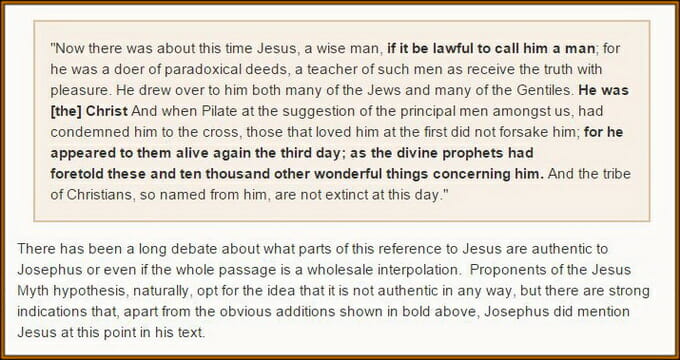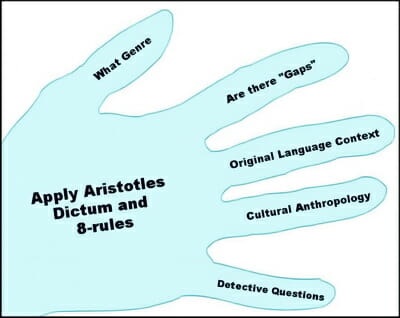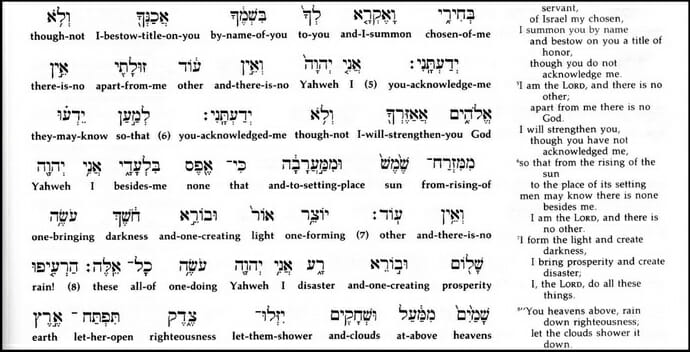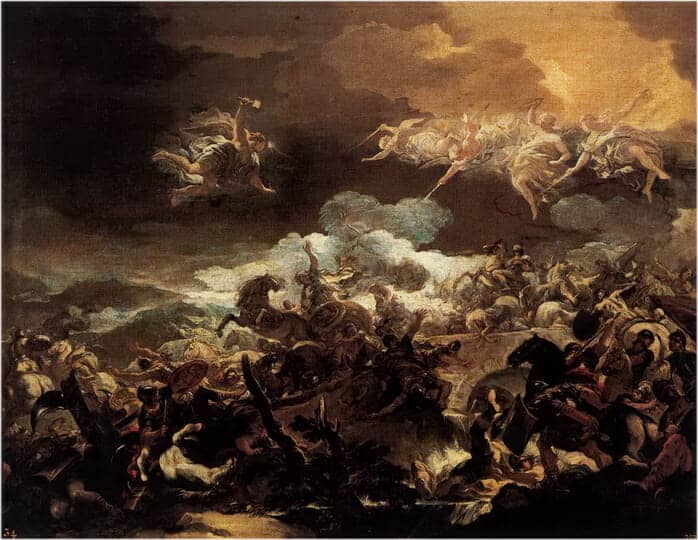William Lane Craig and Kevin Scharp discuss the validity of reasons given for God’s existence at The Veritas Forum: “Is There Evidence For God?” at Ohio State University, 2016. Find this and many other talks at http://www.veritas.org/talks.
Apologetics


Christianity Is the Only Falsifiable Religious Worldview
…and if the Messiah has not been raised, then our message means nothing and your faith means nothing. In addition, we are found to be false witnesses about God because we testified on God’s behalf that he raised the Messiah—whom he did not raise if in fact it is true that the dead are not raised. For if the dead are not raised, then the Messiah has not been raised, and if the Messiah has not been raised, your faith is worthless and you are still imprisoned by your sins. Yes, even those who have died believingin the Messiah are lost. If we have set our hopes on the Messiah in this life only, we deserve more pity than any other people. But at this moment the Messiah stands risen from the dead, the first one offered in the harvest of those who have died. (1 Cor 15:14-20, ISV)
Dr. Gary Habermas gives lecture at UCSB, “The Resurrection Argument That Changed a Generation of Scholars,”is a bit longer but VERY powerful:
The following graphics come with a H-T to NY Apologetics Twitter, and comes by way of Credohouse:
This belief has been a source of contention with many people, even Christians, in the past. But the more I research, the more I find it to be the case that Christianity is the only viable worldview that is historically defensible. The central claims of the Bible demand historic inquiry, as they are based on public events that can be historically verified. In contrast, the central claims of all other religions cannot be historically tested and, therefore, are beyond falsifiability or inquiry. They just have to be believed with blind faith.
Think about it: The believer in the Islamic faith has to trust in a private encounter Muhammad had, and this encounter is unable to be tested historically. We have no way to truly investigate the claims of Joseph Smith (and when we do, they are found wanting). Buddhism and Hinduism are not historic faiths, meaning they don’t have central claims of events in time and space which believers are called upon to investigate. You either adopt their philosophy or you don’t. There is no objective way to test them. Run through every religion that you know of and you will find this to be the case: Either it does not give historic details to the central event, the event does not carry any worldview-changing significance, or there are no historic events which form the foundation of the faith.
This is what it looks like:
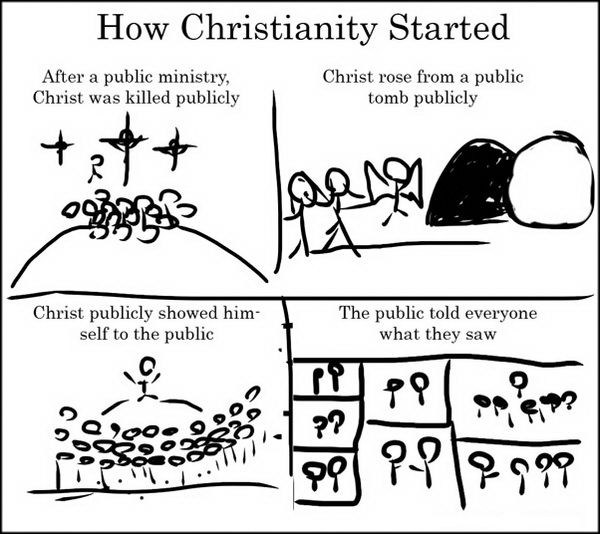
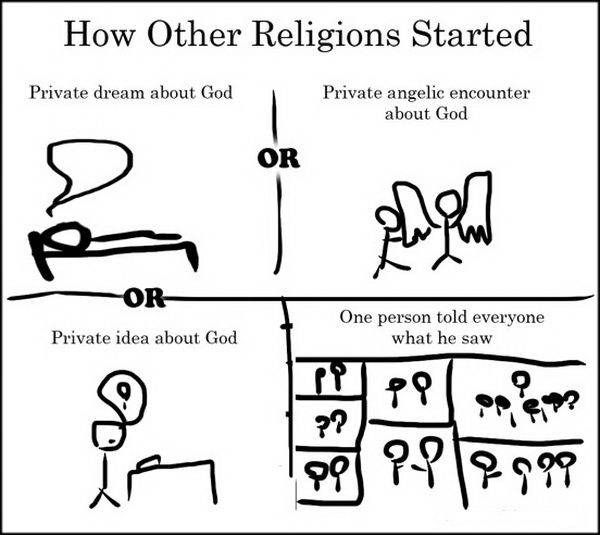
The following is a really good series by INSPIRING PHILOSOPHY, It is a 7-part series (they will all play below, or you can go HERE to play the one you wish) that is worth the watch.
Series
1. The Resurrection of Jesus (Introduction)
2. The Resurrection of Jesus (The Historical Evidence)
3. The Resurrection of Jesus (Origins of the Belief)
4. The Resurrection of Jesus (Advanced Theories)
5. The Resurrection of Jesus (Are Miracles Improbable?)
6. The Resurrection of Jesus (Spiritual Resurrection?)
7. Refuting Biblical Arguments from Silence
J. Warner Wallace’s presentation to the Mars Hill Apologetics Group of North Coast Calvary Chapel. J. Warner is a cold case homicide detective and he hosts the PleaseConvinceMe Podcast (www.pleaseconvinceme.com).

Not All Christians Are Harvesters ~ Greg Koukl
Gregory Koukl (http://www.str.org/) shares his insights into everyone being able to participate in the job of evangelism… even if it is merely putting a pebble in a shoe of the unregenerate. A great thought that every Christian should inculcate.

Presuppositional vs. Evidential vs. Classical Apologetics
People are different… and in being different I think a false dichotomy is made between the schools and one should be well versed in the main schools of apologetics so adaptation can occur in a real-world conversation. Here R.C. Sproul talks about the three main schools of thoughts in this regard (although he is not a fan of the first two he mentions).
- [Key] People have been swayed into the Kingdom by all three of the above, and the many in the video at the bottom. All by the WORK of the Holy Spirit.
I recently came across an article that gave a couple examples of people being persuaded by the evidential aspect of Christianity. This is just a short list of examples via Dr. Norman Geisler:
There is a common misnomer among many Christians that apologetics never helps to bring anyone to Christ. This is a serious misrepresentation of the facts.
1. The Conversion of St. Augustine
There were several significant rational turning points in Augustine’s life before he came to Christ. First, he reasoned his way out of Manichaean dualism. One significant turning point here was the success of a young Christian debater of Manicheans called Helpidius.
Second, Augustine reasoned his way out of total skepticism by seeing the self-defeating nature of it.
Third, were it not for studying Plotinus, Augustine informs us that he would not even been able to conceive of a spiritual being, let alone believe in one.
2. The Conversion of Frank Morrison
This skeptical attorney set out to disprove Christianity by showing the resurrection never occurred. The quest ended with his conversion and a book titled Who Moved the Stone? in which the first chapter was titled “The Book That Refused to be Written”! More recently another unbelieving attorney had a similar journey.
3. The Conversion of Simon Greenleaf
At the turn of the century the Professor of Law at Harvard, who wrote the book on legal evidence, was challenged by students to apply the rules of legal evidence to the New Testament to see if its testimony would stand up in court. The result was a book titled The Testimony of the Evangelists in which he expresses his confidence in the basic documents and truths of the Christian Faith.
4. The Results of Debates
Many people have been led toward or to Christianity as a result of debates we have had with atheists and skeptics. After debating Berkley University philosopher Michael Scriven on “Is Christianity Credible?” the University of Calgary audience voted three to one in favor of Christianity. The campus news paper report read: “Atheist Fails to Convert Campus Christians!” Following a debate on the rationality of belief in Christianity with the head of the philosophy department at the University of Miami, the Christian student leadership held a follow-up meeting. The atheist professor attended and expressed doubts about his view expressed at the debate. It was reported that some 14 people who had attended the debate made decisions for Christ.
After a debate on the Moonie religion at Northwestern University in Evanston, Illinois, a Moonie girl asked some questions about Christianity. I could see that she had been convinced that the Unification Church was not teaching the truth. After talking with her briefly, I introduced her to a female seminary student who led her to Christ.
When sharing the gospel with Don Bly, he informed us that he was an atheist. After reasoning with him from atheism to open-minded agnosticism, he agreed to read Frank Morrison’s book. The evidence for Christ’s resurrection convinced him and we had the privilege of leading him to Christ. He has subsequently raised his family for Christ became a leader in a church south of St. Louis.
May I also posit here Dean H. Kenyon, who received a book by A.E. Wilder-Smith from one of his students where Dr. Wilder-Smith challenged his [Dr. Kenyon’s] widely accepted book by evolutionists of the day. After reading it Dr. Kenyon could not refute the critique of his work by Dr. Wilder Smith:
The following interview was held with Dean Kenyon, the professor of biology at the University of San Francisco, who was for many years a staunch evolutionist, wrote the book Biochemical Predestination (McGraw-Hill, 1969), which was the best-selling advanced level university textbook on chemical evolution during the decade of the 70s. One of Dean Kenyon’s students gave him a copy of a book written by Dr. A. E. Wilder-Smith (who holds three earned doctorates) entitled The Creation of Life: A Cybernetic Approach to Evolution. In this book by Dr. Wilder, Dr. Kenyon’s book is critiqued.
Instead of Kenyon saying Well, Dr. Wilder is just a creationist, who would listen to him? Dr. Kenyon read the book and tried to answer the arguments in it against his own book. When he couldn’t, he began to investigate where the evidence led to. It ended up leading outside of his previously held naturalistic presuppositions commonly known as evolution.
So evidence brought him to the stark truth of his starting point. A combined one-two-punch.
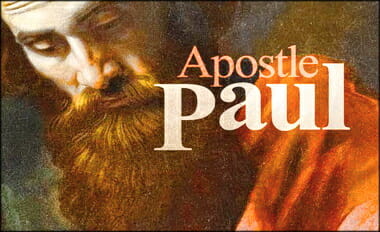
Did Paul Have The Authority To Arrest People in Damascus?
(Per my usual modus operandi, all pics are linked)
Defending Acts Historicity/Archaeology
- Quotes on Archaelogy
- 25,000 Sites
- William Ramsay
- (Pivot) Answering the Objection
- Tektonics Site Bullet Pointed
- Bible Apologetics Site’s Bullet Pointed
Commentaries:
- Commentary on the Book of Acts, NICNT
- Exposition of the Acts of the Apostles, vol. 17, New Testament Commentary
- Acts, The Expositor’s Bible Commentary – John and Acts, vol 9
- The Acts of the Apostles: A Socio-Rhetorical Commentary
- New Testament Background Commentary: A New Dictionary of Words, Phrases and Situations in Bible Order
- The IVP Bible Background Commentary: New Testament
- The Interpretation of the Acts of the Apostles
…Additional resources as I find them…
For reference, we are dealing with the first four verses of Acts chapter 9, I will include the main story for clarity:
Meanwhile, Saul was still breathing threats and murder against the disciples of the Lord. He went to the high priest and requested lettersfrom him to the synagogues in Damascus, so that if he found any men or women who belonged to the Way, he might bring them as prisoners to Jerusalem. As he traveled and was nearing Damascus, a light from heaven suddenly flashed around him. Falling to the ground, he heard a voice saying to him, “Saul, Saul, why are you persecuting Me?”
“Who are You, Lord?” he said.
“I am Jesus, the One you are persecuting,” He replied. “But get up and go into the city, and you will be told what you must do.”
The men who were traveling with him stood speechless, hearing the sound but seeing no one. Then Saul got up from the ground, and though his eyes were open, he could see nothing. So they took him by the hand and led him into Damascus. He was unable to see for three days and did not eat or drink.
(Acts 9:1-9, Holman Christian Standard Bible [HCSB])
CHALLENGE
I had an interesting challenge… one that I have never heard before. Here is the challenge:
But Saul (Paul) was an obvious fraud if you understand ancient Roman law. There is no possible way that a Roman ‘provinciale’ citizen of Judea would have any authority to travel to the neighboring province of Syria to extradite religious heretics (also Roman citizens) back to Jerusalem.
The high priest and Sanhedrin in Judea were only allowed to involve themselves in Judean affairs. Even then, there is not a single shred of text in Roman, Sanhedrin, or independent record that supports or even mentions such a bounty hunter practice. Only the bible in Saul’s imagination.
If you are aware of a corroborating source outside the bible, I’d love to see it. I have been searching for one for 20+ years now.
As we will see, he has been searching in the wrong places. Later in conversation the challenge was restated a bit after I said Paul was “arresting Jews who became Christians. In fact, all the early converts were Jewish? He wasn’t arresting Roman citizens?”
RESTATED
All Judeans were considered Roman Provinciale citizens, and taxpayers to Rome. Hence the revolt…. Syrian provincials, also taxpaying Roman citizens. He would not have any legal authority to arrest anyone in Damascus, and there is no record of this practice outside the bible.
(I will build a case for the reliability of Luke before answering the specific charge)
I pointed out of course that this is an argument from silence. There ends up being good evidence of this being a special agreement with Rome and the Jewish religious leaders as part of Rome preserving their version of religious freedom, but my point still stands:
ACTS HISTORICITY
I find it doubtful that most of the historical points in Paul’s life are real… but this is not.
It reminds me of times when archaeologists said there is no archaeological evidence for Abraham, no archaeological evidence for the Hittites, no archaeological evidence for King David, no archaeological evidence for the Pool of Bethesda… etc., etc.
And then walla… all of a suddenly these people who said the Bible was not real because it made up “whole-cloth” these places.
Now there is — an example — an entire museum dedicated to the Hittites.
QUOTES
Besides my example above of the previous VERY SMALL list of attack on the Bible via skeptics arguing from silence and later being proven wrong, to wit:
- “There can be no doubt that archaeology has confirmed the substantial historicity of Old Testament tradition.” – Dr. William F. Albright, Archaeology and the Religions of Israel (Johns Hopkins University Press, Baltimore, 1956), p. 176.
- “On the whole, however, archaeological work has unquestionably strengthened confidence in the reliability of the Scriptural record. More than one archaeologist has found his respect for the Bible increased by the experience of excavation in Palestine….Archaeology has in many cases refuted the views of modern critics. It has shown, in a number of instances, that these views rest on false assumptions and unreal, artificial schemes of historical development. This is a real contribution and not to be minimized.” – Millar Burrows, Professor of Archaeology at Yale University, What Mean These Stones? (Meridian Books, New York, NY, 1956), p. 1
- “The excessive skepticism of many liberal theologians stems not from a careful evaluation of the available data, but from an enormous predisposition against the supernatural.” – Professor Millar Burrows (Professor of Archaeology at Yale University), What Mean These Stones? (Meridian Books, New York, NY, 1956), p. 176.
- “It may be stated categorically that no archaeological discovery has ever controverted a Biblical reference. Scores of archaeological findings have been made which confirm in clear outline or exact detail historical statements in the Bible. And, by the same token, proper evaluation of Biblical description has often led to amazing discoveries.” – Dr. Nelson Glueck, Rivers in the Desert (New York: Farrar, Strous and Cudahy, 1959), 136.
- “I set out to look for truth on the borderland where Greece and Asia meet, and found it there. You may press the words of Luke in a degree beyond any other historian’s and they stand the keenest scrutiny and the hardest treatment.” – Sir William Ramsey (eminent archaeologists who changed his mind regarding Luke after extensive study in the field), (1915), The Bearing of Recent Discovery on the Trustworthiness of the New Testament (Grand Rapids, MI: Baker, 1975 reprint), page 89.
But most importantly about the author of Acts:
“Luke is a historian of the first rank; not merely are his statements of facts trustworthy; he is possessed of the true historic sense…In short this author should be placed along with the very greatest of historians.” ~ Sir William Ramsey (archaeologist), The Bearing of Recent Discovery on the Trustworthiness of the New Testament, 1915, pages 81, 222
To wit, this external evidence for the reliability of the Bible is immense:
25,000 SITES CONFIRM N.T.
More than 25,000 sites confirm, in clear outline or exact detail, historical statements in the Bible. Archeologist Nelson Glueck wrote, “No archaeological discovery has ever controverted a biblical reference.” Archeologists have found the bones of a first-century crucifixion victim confirming the accuracy of the New Testament writers.
The “Nazareth Decree,” issued by Emperor Claudius between 41-54, threatens tomb robbers with death instead of the usual fine, possibly because rumors were still circulating about the body of Christ being stolen!
Colin Hemer’s text confirms hundreds of archaeological finds that support specific persons, events, and facts presented in Luke and Acts alone. The confirmation of historicity for Acts is overwhelming.
William Ramsay, the skeptical archaeologist and foremost authority of his day on the history of Asia Minor, was converted to faith because of the ACCURACY and historicity of the book of Acts, here is a snippet from a wonderful book entitled, A Zeal For God Not According to Knowledge:
WILLIAM MITCHELL RAMSAY
RAMSAY CONVERTED BY LUKE’S HISTORICAL RELIABILITY
What archeological evidence is there for the New Testament’s reliability generally, and Luke’s in particular? The English archeologist Sir William Ramsay (professor of humanity at Aberdeen University in Scotland, 1886-1911) had been totally skeptical about the accuracy of the New Testament, especially the writings of Luke. After going to what is now Turkey, and doing a topographical study, he totally reversed his thinking. After reconsidering, he wrote: “Luke is a historian of the first rank; not merely are his statements of fact trustworthy; he is possessed of the true historic sense… this author should be placed along with the very greatest of historians.” He had believed, as per nineteenth-century German higher criticism, that Acts was written in the second century. But he found it must have been written earlier, because it reflected conditions typical of the second half of the first century. After having gone to Asia Minor (Turkey) to do archeological and topographical work, Ramsay discovered Luke’s reliability:
It was gradually borne upon me that in various details the narrative [of Luke in Acts] showed marvelous truth. In fact, beginning with a fixed idea that the work was essentially a second-century composition, and never relying on its evidence as trustworthy for first-century conditions, I gradually came to find it a useful ally in some obscure and difficult investigations.
So when Maccoby writes that Luke’s description of Paul’s defense before Agrippa “has the atmosphere of fiction, and is full of unhistorical aspects:’ he is ignoring the implications of the reality that whenever Luke could be checked, he has repeatedly proven to be correct.[66]
[66] W.M. Ramsay, The Bearing of Recent Discovery on the Trustworthiness of the New Testament (Grand Rapids, MI: Baker Book House, 1953), 222; William Ramsay, St. Paul the Traveler and the Roman Citizen (Grand Rapids, MI: Baker Book House, 1962), 7-8; McDowell, Evidence That Demands a Verdict, 1:70; Maccoby, The Mythmaker, 171.
Eric Snow, A Zeal For God Not According to Knowledge: A Refutation of Judaism’s Arguments Against Christianity, 2nd Edition (New York, NY: iUniverse Inc., 2005), 82-83.
~ PIVOT ~
Nothing has changed other than MORE archaeological proofs have substantiated Acts since Ramsey’s time. But now we will pivot to a more specific refutation of the challenge by first allowing the honest “what we do not know” into the conversation as well as “what we do know.”
What we do not know is “that we have no certain information as to whether the Sanhedrin had this kind of power.” But what we do know or can question is this:
TEKTONIC
- a question as to whether Rome was in control of the city at this time or the Nabeteans were
- We do know that Damascus was known in Jewish history and thought as a place of refuge and exile… it is conceivable that Jewish Christians would flee there.
- We also know that the Sanhedrin had jurisdiction as a legislative body over Jews throughout the Diaspora
- collecting the Temple tax abroad
- and that Jews had the right of internal discipline in their synagogues
- Therefore, we could conceive of some sort of right of extradition,
- especially since we know that the Romans granted this right to Judaea as a sovereign state under the Hasmoneans
- and that this privilege was renewed in 47 BC
Tektonics continues in their summation: “But the question is really not relevant, because we don’t know whether Saul/Paul would have been successful in his intentions, whatever they were – remembering that he was stopped cold by his encounter with the Risen Christ.”
Another site words the challenge thus:
- It has been claimed there is no historical basis for Paul’s commission from the High Priest to extradite from Damascus to Jerusalem any Jews who had become Christians, and that neither the High Priest nor the Sanhedrin had any jurisdiction in Damascus.
BIBLE APOLOGETICS
And then is the refutation:
- Peerbolte raises a parallel in the history of the Maccabees, in which a Roman consul ordered Jewish rebels in Egypt to be extradited to the High Priest for punishment according to Jewish law
- [F.F.] Bruce defends it with reference to a decree by Julius Caesar re-affirming all the previously held rights of the High Priest [quoted below]
- Kistemaker and Hendriksen likewise believe the High Priest actually had extradition authority [quoted below]
- Dunn disputes the idea of formal jurisdiction, [BUT] notes the informal influence of the high priest and Sanhedrin over provincial synagogues was far higher.
- Wallace and Williams approach the legal-historical background with care. Observing the letters were addressed to the synagogues not local officials, they argue the matter was internal Jewish business in which Roman officials would not become involved….
- Noting the apparent absence of Roman forces in Damascus at the time, they suggest this would have reduced the probability of Roman interference.
So we see some great evidence from history and culture that would allow such a practice to have happened… but again to repeat Tektonics,
- “But the question is really not relevant, because we don’t know whether Saul/Paul would have been successful in his intentions, whatever they were – remembering that he was stopped cold by his encounter with the Risen Christ.”
Amen, and Amen.
20[+] Year Search Answered
So here is effectively how the discussion ended. The skeptic wanted — essentially — paperwork from Paul’s time-period rather than a few years prior showing authority to do this. This is an unreasonable request and show the “enmity” between the natural man and God (including reasonable evidence for their countering their pet peeves ~ Romans 8:7). Why is this unreasonable? Simply because filing, file cabinets, computers, computer server back-ups, copy machines, and the like were not the normal order then.
So all the historian needs to do is show that this happened close to the time, coupled with the dual-citizen Saul knowing that this extradition was still possible under past/current laws. Until a specific “order” of cease-and-desist can be shown, it is REASONABLE to assume the players involved here knew from history that the law was still up-and-running.
This is the reason I included the many commentaries below, because they show basically the following to some extent or another:
- Extradition from Egypt was granted for Simon the high priest by Ptolemy VII in 142 B.C. (1 Macc. 15:15-21)
- Julius Caesar formally acknowledged the sovereignty of the high priest in all matters of Jewish religion in a decree of 47 B.C. (Josephus, Ant. 14. 192-195)
(via John B. Polhill)
Of course, apropos of my presented response the skeptic merely countered with the time between Julias Caesars death and Saul (Paul), and then said “do you know how many laws have changed in America in a similar time-period?” Unfortunately for him, this is not how history is interpreted — that is, by applying 21st Century customes to the B.C. and A.D. shift in rulers and laws in Rome. So the skeptic felt unfulfilled, but I can now teach well on these three verses in a class setting preparing younger (and older) minds to combat secular silliness and encourage them in their faith.
Here are some great commentaries to support this historicity. I include pics because the people I deal with think I “google” stuff, little do they know. (In fact, in referencing my own site they mentioned my site is biased when I merely used my own library to note stats in a post/challenge on “religious wars” from The Encyclopedia of War.)
BTW, much thank to Bible Apologetics for all the work done there (part 1, part 2, part 3, part 4, part 5). They led me to my own book case (pics added) or my Logos program.
Commentaries
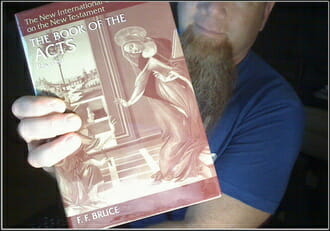
- F.F. Bruce, Commentary on the Book of Acts, NICNT (Grand Rapids, MI: Willaim B. Eerdmans Publishing Co., 1988), 180-181.
2. When the Jewish state won its independence under the Hasmonaean dynasty of ruling priests (142 B.C.), the Romans, who patronized the new state for reasons of their own, required neighboring states to grant it the privileges of a sovereign state, including the right of extradition. A letter delivered at that time by a Roman ambassador to Ptolemy VIII of Egypt concludes with the demand: “If any pestilent men have fled to you from their own country [Judaea], hand them over to Simon the high priest, so that he may punish them according to their law” (1 Macc. 15:21). In 47 B.C. Julius Caesar confirmed those rights and privileges anew to the Jewish nation (although Judaea was no longer a sovereign state), and more particularly to the high-priesthood.[5] Luke’s narrative implies that the right of extradition continued to be enjoyed by the high priest under the provincial administra¬tion set up in A.D. 6. The followers of The Way whom Saul was authorized to bring back from Damascus were refugees from Jerusalem, not native Damascene disciples. The charge against them may have been complicity in Stephen’s offense against the temple.
“The Way” is a designation for the new movement used several times in Acts (19:9, 23; 22:4; 24:14, 22; cf. also 16:17; 18:25-26). It was evidently a term used by the early followers of Jesus to denote their movement as the way of life or the way of salvation. Similar words are used in a religious sense elsewhere; a specially close parallel is the use of the Hebrew word for “way” in the Zadokite Work and other documents of the Qumran community to denote the membership and life-style of that community.[6]
The history of Damascus goes back to remote antiquity. It was a city in the days of Abraham, and at the time of the Israelite monarchy it was the capital of the most important Aramaean kingdom. Later it was the seat of administration of an Assyrian province. In Hellenistic times it was com¬pletely replanned, on the Hippodamian grid-system. From 64 B.C. on it belonged to the Roman province of Syria, but had a measure of municipal autonomy in the loose federation of cities called the Decapolis. There was a very large Jewish population in the city,[7] so it is not surprising that there were several synagogues, each exercising disciplinary supervision over its members.
[5] Josephus, Ant. 14.192-95; see S. Safrai and M. Stern (ed.), The Jewish People in the First Century, I (Assen, 1974), p. 456.
[6] CD 1.13; 2.6; 1QS 9.17-18; 10.20-21; see E. Repo, Der “Weg” als Selbst-bezeichnung des Urchristentums, AASF B 132.2 (Helsinki, 1964). The Zadokite Work, discovered toward the end of the nineteenth century in two mutilated manuscripts in the ancient synagogue of Fostat (Old Cairo), and first published in Fragments of a Zadokite Work, ed: S. Schechter, I (Cambridge, 1910), revealed the presence in Damascus of a Jewish group (now known to have been closely related to, if not identical with, the Qumran community) bound together by covenant as a new and purified Israel, devoted to the Zadokite priesthood and a distinctive form of the messianic hope. See L. Ginzberg, An Unknown Jewish Sect (New York, 1976); P. R. Davies, The Damascus Covenant, JSOT Sup. 25 (Sheffield, 1983); also G. Vermes, The Dead Sea Scrolls in English (Har-mondsworth, 1975), pp. 95-117. If the “Damascus” of this document is to be understood literally, it may be asked what relation the covenanters of Damascus bore to the local disciples of Jesus, but it is probably impossible to answer the question with anything like certainty.
[7] According to Josephus, BJ 2.561, the outbreak of the Judaean revolt in A.D. 66 was marked by the massacre of 10,500 Damascene Jews; in BJ 7.368, their number has risen to 18,000.
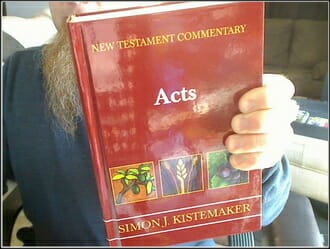
- Simon J. Kistemaker and William Hendriksen, Exposition of the Acts of the Apostles, vol. 17, New Testament Commentary (Grand Rapids: Baker Book House, 1953–2001), 329–330.
b. “He went to the high priest.” The high priest served as head of the Sanhedrin, which as a legislative body had jurisdiction over the Jews living in Jerusalem, Palestine, and the dispersion. Thus the high priest had power to issue warrants to the synagogues in Damascus for the arrests of Christian Jews residing there (see 9:2; 22:5; 26:12).[1] Did the Romans permit religious persecution in their provinces? We are not sure whether at that time the Roman government had full control over Damascus. In the fourth decade of the first century, the Nabatean Arabs under the leadership of Aretas IV were exerting their influence on that city and gave the Damascenes temporary autonomy. The Nabateans and Jews probably collaborated because of their anti-Roman stance.
From the New Testament and other historical records we know that the high priest was Caiaphas, the son-in-law of Annas.[2] Nevertheless, Annas exercised the authority of high priest, as is evident from verse 14, where the plural term chief priests occurs.
c. “And asked him for letters to the synagogues in Damascus.” That city gave residence to a large Jewish population, so that for centuries Damascus had its own Jewish quarter (compare v. 22).[3] Consequently, Jewish synagogues were common in the Syrian capital. From the annals of Jewish history we learn that at the time of the Jewish war against Rome (a.d. 66), no fewer than ten thousand Jews were killed in Damascus.
Scripture tells us that Damascus already existed in the time of Abraham (Gen. 14:15; 15:2), was conquered by David (2 Sam. 8:6), regained independence during the reign of Solomon (1 Kings 11:24–25), and became a hotbed of hostility toward Israel and eventually dominated it for some time (Amos 1:3–5). During the Roman conquest (64 b.c.), Damascus was the seat of government for Rome’s Syrian province and one of the ten cities in the region known as the Decapolis (Mark 5:20; 7:31). The Nabatean Arabs ruled the Arabian desert area and under the leadership of Aretas IV, who was the father-in-law of Herod Antipas (Matt. 14:3; Mark 6:17; Luke 3:19), controlled Damascus for a few years (2 Cor. 11:32).
Damascus is situated along the Abana River, from which it draws water to irrigate the sun-parched landscape in and around the city. In Paul’s day, to journey on foot from Jerusalem to Damascus took about five or six days to cover the approximate distance of 150 miles. The city was a commercial center where caravans converged from all directions in the ancient world and where the Christian faith began to flourish. Paul realized that from Damascus, the gospel of Christ would spread throughout the world. For that reason, he wanted to stop the influence of Christianity and asked the high priest for warrants to arrest Christians, both men and women, in the Damascus synagogues. He knew that among the worshipers in the local assemblies were countless followers of Jesus Christ. Here Paul intended to make multiple arrests.
d. “If he found any persons who belonged to the Way.” In the beginning, Christians used a variety of names to identify themselves. The term the Way is one of the first names that describes the Christian faith (compare the term the Name [5:41]). In Acts it appears a few times (19:9, 23; 22:4; 24:14, 22). The term denotes the teaching of the gospel,[4] the Christian’s conduct directed and guided by this gospel, and the Christian community in general. Granted that the believers formed a distinct group, they nevertheless continued to meet with fellow Jews in the Damascus synagogues. As a result, the rulers of these synagogues could readily identify the followers of the Way; Paul intended to depend on the rulers for help in arresting the Christians. He planned to lead Christ’s followers as bound prisoners to Jerusalem, where they would have to stand trial.
[1] Emil Schürer, The History of the Jewish People in the Age of Jesus Christ (175 B.C.—A.D. 135), rev. and ed. Geza Vermes and Fergus Millar, 3 vols. (Edinburgh: Clark, 1973-87), vol. 2, p. 218.
[2] Matt. 26:3; Luke 3:2; John 11:49; 18:13-14, 24, 28; Acts 4:6.
[3] Josephus War 2.20.2 [561]; 7.8.7 [368].
[4] Consult Wilhelm Michaelis, TDNT, vol. 5, p. 89; Günther Ebel, NIDNTT, vol. 3, p. 942.
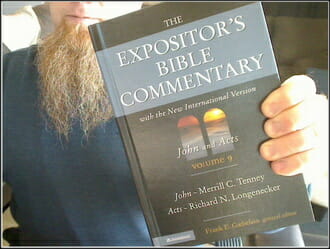
- Richard N. Longenecker, Frank E. Gaebelein, gen. ed., Acts, The Expositor’s Bible Commentary – John and Acts, vol 9 (Grand Rapids, MI: Zondervan Publishing, 1981), 368-370.
It is, of course, impossible today to speak with certainty about what was going on in Saul’s subconscious mind at the time, for psychoanalysis two millennia or so later is hardly a fruitful exercise. His own references as a Christian to this earlier time in his life, however, do not require us to view him as struggling with uncertainty, doubt, and guilt before becoming a Christian. They rather suggest that humanly speaking he was immune to the Christian proclamation and immensely satisfied with his own ancestral faith (cf. my Paul, pp. 65-105). While he looked forward to the full realization of the hope of Israel, Paul seems from his reminiscences of those earlier days to have been thoroughly satisfied with the revelation of God that was given through Moses and to have counted it his chief delight to worship God through those revealed forms. Nor need we suppose that the logic of the early Christian preachers greatly affected Paul. His later references to “the offense of the cross” show that for him the cross was the great stumbling block to any acknowledgment of Jesus of Nazareth as Israel’s Messiah—a stumbling block no amount of logic or verbal gymnastics could remove (cf. 1 Cor 1:23; Gal 5:11; note also Justin Martyr, Dialogue 32, 89).
It is probable that Saul took up his brutal task of persecution with full knowledge of the earnestness of his opponents, the stamina of the martyrs, and the agony he would necessarily cause. Fanaticism was not so foreign to Palestine in his day as to leave him unaware of these things, and it is quite possible that he was prepared for the emotional strain involved in persecuting those he believed to be dangerous schismatics within Israel.
More important, however, in days when the rabbis viewed the keeping of the Mosaic law as the vitally important prerequisite for the coming of the Messianic Age (cf. b Sanhedrin 97b-98a; b Baba Bathra 10a; b Yoma 86b), Paul could validate his actions against the Christians by reference to such godly precedents as (1) Moses’ slaying of the immoral Israelites at Baal-peor (cf. Num 25:1-5); (2) Phinehas’s slaying of the Israelite man and Midianite woman in the plains of Moab (cf. Num 25:6-15); and (3) the actions of Mattathias and the Hasidim in rooting out apostasy among the people (cf. 1 Macc 2:23-28, 42-48). Perhaps even the divine commendation of Phinehas’s action in Numbers 25:11-13 rang in his ears:
Phinehas son of Eleazar, the son of Aaron, the priest, has turned my anger away from the Israelites; for he was as jealous as I am for my honor among them, so that in my zeal I did not put an end to them. Therefore tell him I am making my covenant of peace with him. He and his descendants will have a covenant of a lasting priesthood, because he was zealous for the honor of his God and made atonement for the Israelites.
Second Maccabees 6:13 counsels that “it is a mark of great kindness when the impious are not let alone for a long time, but punished at once.”
The DSS define a righteous man as one who “bears unremitting hatred toward all men of ill repute” (1QS 9.22). They speak of unswerving allegiance to God and his laws as alone providing a firm foundation for the Holy Spirit, truth, and the arrival of Israel’s hope (cf. 1QS 9.3-4, 20-21) and call for volunteers who are blameless in spirit and body to root out apostasy in the final eschatological days (cf. 1QM 7.5; 10.2-5). The Qumran psalmist, in fact, directly associates commitment to God and his laws with zeal against apostates and perverters of the law when he says:
The nearer I draw to you, the more am I filled with zeal against all that do wickedness and against all men of deceit. For they that draw near to you cannot see your commandments defiled, and they that have knowledge of you can brook no change of your words, seeing that you are the essence of right, and all your elect are the proof of your truth (1QH 14.13-15).
With such precedents and parallels, coupled with the rising tide of messianic expectation within Israel, Saul could very well have felt justified in mounting a further persecution against the Christians. Probably he felt that in light of Israel’s rising messianic hopes the nation must be united and faithful in its obedience to the law and kept from schism or going astray. In his task, he doubtless expected to receive God’s commendation. According to 1 Maccabees, Judah, Jonathan, and Simeon (the three great Hasmonean rulers) established friendly relations with Rome (cf. 1 Macc 8:17-32; 12:1-4; 14:16-24), a reciprocal extradition clause being included in Rome’s reply to Simeon (cf. 1 Macc 15:15-24). And the decrees of the Roman senate that Josephus records appear to indicate that the treaties of friendship between Rome and the Jewish people were renewed in the time of John Hyrcanus (cf. Antiq. XIII, 259-66 [ix.2]; XIV, 145-48 [viii.5]). While the Sadducean high priests of Jerusalem no longer exercised the civil authority of their predecessors, they were, it seems, recognized by Rome as the titular rulers of their people in most internal matters; and evidently they retained the right of extradition in strictly religious situations. Therefore Saul, seeking the return of Jewish Christians, “went to the high priest and asked him for letters to the synagogues in Damascus, so that if he found any there who belonged to the Way, whether men or women, he might take them as prisoners to Jerusalem” (cf. 22:5; 26:12).
Damascus was a large and thriving commercial center at the foot of the Anti-Lebanon mountain range. Since 64 B.C. it had been part of the Roman province of Syria and was granted certain civic rights by Rome as one of the ten cities of eastern Syria and the Transjordan called the Decapolis (cf. Mark 5:20; 7:31). It had a large Nabatean Arab population, and possibly was ruled by the Nabatean king Aretas IV (9 B.C.-A.D. 40) at some time during this period (cf. 2 Cor 11:32). It also had a large Jewish population, 10,500 of whom Josephus reports were killed by the people of Damascus at the outbreak of Jewish-Roman hostilities in A.D. 66 (cf. War II, 561 [xx.2]; though in War VII, 368 [viii.7] the figure is 18,000). It was to this city that Saul went with the authority of the Jewish Sanhedrin, seeking to return to Jerusalem those Christians who had fled the city—chiefly the Hellenistic Jewish Christians—in order to contain the spread of what he considered to be a pernicious and deadly contagion within Israel.
While we have spoken repeatedly of the early believers in Jesus as Christians, the term “Christian” (Christianos) was first coined at Antioch of Syria (cf. 11:26) and appears only three times in the entire NT (11:26; 26:28; 1 Peter 4:16). Before being named at Syrian Antioch and during the early existence of the church, those who accepted Jesus’ messiahship and claimed him as their Lord called themselves those of “the Way” (hē hodos, as here and at 19:9, 23; 22:4; 24:14, 22; cf. also 16:17; 18:25-26), while their opponents spoke of them as members of “the sect of the Nazarenes” (hē hairesis tan Nazōraiōn; cf. 24:5, 14; 28:22). The origin of the absolute use of “the Way” for Christians is uncertain, though it surely had something to do with the early believers’ consciousness of walking in the true path of God’s salvation and moving forward to accomplish his purposes. In the vignette of 9:1-30, it is synonymous with such self-designations as “the disciples of the Lord” (vv.2, 10, 19), “saints” (v.13), “all who call on your [Jesus’] name” (v.14), and “brothers” (vv.17, 30).
Additional Notes:
2 Some have noted that in 9:1-2, 14, and 26:10, 12, it is the high priest (or “chief priests”) from whom Saul received letters of authority, whereas in 22:5 he is shown as saying that he obtained letters from the whole council (i.e., “the high priest and all the council”). The difference, however, is merely verbal and hardly worth commenting on.
3-6 Though the apparition of 2 Macc 3 of the great horse, its frightful rider, and the two accompanying youths who attacked Heliodorus finds a parallel in Luke’s portrayal here, the resemblances are superficial.
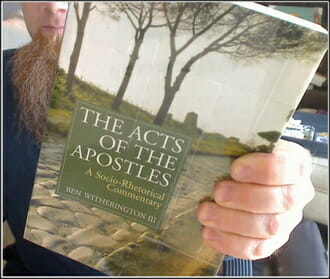
- Ben Witherington III, The Acts of the Apostles: A Socio-Rhetorical Commentary (Grand Rapids, MI: Wm. B. Eerdmans Publishing Co., 1998), 315–316.
Probably too much ink has been spilled on whether the high priest actually had such right of extradition during this period. In the first place our text says nothing about a legal right; the impression left is that the high priest was providing letters requesting permission for such actions by Saul. But even if a right is in view here, it is possible that the material found in Josephus, Ant. 14.192–95 is of relevance. There we are told that Julius Caesar confirmed such rights and privileges to the Jewish people and the high priest in particular, even though they were no longer a sovereign or independent state. This privilege may have still existed in Saul’s day.[41]
[….]
Damascus was an important city 135 miles north-northeast of Jerusalem. Lying on the main route from Egypt to Mesopotamia, it became a commercial center. Part of the league of cities known as the Decapolis (Pliny, Nat. Hist. 5.74), it had a considerable Jewish population (cf. Josephus, War 2.561). This city formed part of the Roman province of Syria from 64 b.c. on, but retained its municipal independence as part of the Decapolis.[45] There is perhaps incidental confirmation of Saul’s conversion near or in this city in the reference to a “return” to Damascus in Gal. 1:17.
[41] This is of more relevance than the earlier material found in 1 Macc. 15:21, where a Roman ambassador requests extradition of Ptolemy VII in 138 b.c. with the person in question to be handed over to the high priest. See the discussion in Bruce, The Acts of the Apostles, p. 233, and Marshall, Acts, p. 168.
[45] See Bruce, The Acts of the Apostles, p. 233, and the discussion of Syria in general by Tracy, “Syria.”
- Harold Mare, New Testament Background Commentary: A New Dictionary of Words, Phrases and Situations in Bible Order (Ross-shire, UK: Mentor, 2004), 163–164
9:2. to the high priest… for letters. Probably Caiaphas and/or Annas, his father-in-law, and possibly also members of the high priest’s family and the Sanhedrin (cf. 4:5, 6, 15).
the synagogues in Damascus. Damascus was located in the Roman province of Syria and was a member of the Decapolis group of cities (Matt. 4:24; Mark 5:20; 7:31), which were mainly located in Syria and the Transjordan. At this time Damascus was under the rule of the Nabataeans under King Aretas IV (2 Cor. 11:32), and had a large Jewish population. Damascus was 80 to 90 miles north of the Decapolis cities of Abila and Capitolias, and was about 150 miles north of Jerusalem, a distance taking several days to traverse.
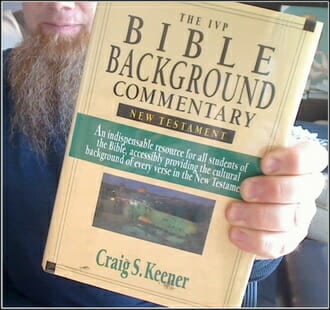
- Craig S. Keener, The IVP Bible Background Commentary: New Testament (Downers Grove, IL: InterVarsity Press, 1993), Ac 9:1–2.
9:1–2. Official letters of introduction authorizing or recommending their sender were common, and Josephus confirms that Palestinian agents could take orders from the Jerusalem Sanhedrin. Jewish communities outside Palestine respected the high priest, and letters from him authorize Saul to carry out his mission with the full cooperation of synagogues there. Because the high priest had exercised extradition rights over fugitive Judeans when he ruled Palestine under the Romans, local synagogues in Syria likely still recognized this right, although the local ruler would probably not. These synagogue communities could cooperate with Saul in his mission to weed out the Jewish Christians.
The Essene sect at Qumran also described itself as “the way”; this was a natural designation for a group that believed that it alone followed the way of righteousness. Essenes had apparently also settled in Damascus, if their writings on this point are meant literally. Tens of thousands of Jews lived in Damascus (as many as eighteen thousand were massacred there in a.d. 66).
- C. H. Lenski, The Interpretation of the Acts of the Apostles (Minneapolis, MN: Augsburg Publishing House, 1961), 350–351.
2) Caiaphas was still the high priest, for not until the year 36 did Jonathan, a son of Annas, and in 37 Theophilus, another son of Annas, succeed Caiaphas; the latter were not sons of Caiaphas (R., W. P.). The authorization Saul desired was not requested from the high priest alone but from him as being head of the Sanhedrin who issued “the letters” on vote of the entire body as we see from 22:5; 26:10.
The middle ᾐτήσατο is not to be understood in the sense that Saul asked these letters “as a favor to himself” (R., W. P.); the middle of this verb is used with reference to business transactions, when business claims are made. So here the great business of persecuting the Christians had been officially delegated to Saul, and in prosecuting this business of his “he asked in due order” for documents that would enable him to execute this business of his also in Damascus. While Saul had his heart and soul in this persecution, it was not a private enterprise of his, could not be in the nature of the case, but an official enterprise of the supreme Jewish court itself with Saul as its head agent. For the persecutions in Jerusalem he had as his assistants a body of Levite police that had been granted him by the Sanhedrin in order to hale men and women to prison (8:3) and he was similarly equipped with police when he was authorized to operate in Damascus.
Damascus, the oldest city in the world (apparently a city already in Abraham’s time, B. C. 1912, Gen. 14:15; 15:2) that still exists as a famous city, had a large number of resident Jews and, as Luke’s plural shows, a number of synagogues. Nero butchered 10,000 Jews in Damascus. It was under the rule of King Aretas three years after the event narrated in this section and must have been strongly Jewish when Saul went there on his errand. The Roman emperors granted the Sanhedrin authority over Jews outside of Palestine, and Aretas was a Roman vassal. What this authority included and in what territory the Sanhedrin might exercise it, is uncertain; but Saul’s expedition to Damascus evidently assumes that arrests could be made there and the prisoners brought to the Sanhedrin in Jerusalem for trial. We have “both men and women” as in 8:3.
Additional Resources
- John B. Polhill, Paul and His Letters (Nashville, TN: B&H Academic), 45-47.
Paul’s persecuting (9:1-2; 22:3-5; 26:4-5, 9-12). In his two testimonies, Paul began by noting his Jewish heritage. He was brought up in a Jewish family in Tarsus, trained in the law under Gamaliel, zealous for God (22:3; 26:4). He had lived by the “strictest sect” of the Jewish religion—a Pharisee (26:5). Paul’s Jewish background was essential to the argument of his speeches before the temple mob and Agrippa. It was not necessary in the conversion narrative of Acts 9. What was essential there was Paul’s preconversion role of being the ravager of the church. So that is where Luke began. Paul was “breathing out murderous threats against the Lord’s disciples” (9:1). Paul was so intense in his persecution of the Christians that he drew his very breath from the threats and slaughter which he harbored against them. Paul’s testimonies go into greater detail: he persecuted the Christians “to death,” dragging off both men and women to prison (22:4); when it was a question of the death penalty, he “cast [his] vote against them” (26:10). Paul’s persecuting in Jerusalem is not elaborated in Acts.’ The only death detailed by Luke is that of Stephen. Paul need not have been a member of the Sanhedrin, even though his testimony would indicate that the chief priests gave him authorization for his persecuting activities (26:10). Paul went into the greatest detail about his persecuting in his testimony before Agrippa. There he noted how he had consistently attempted to make the Christians “blaspheme”; that is, to renounce the name of Christ (26:11a). He added that he extended his persecution “even . . . to foreign cities” (25:1 lb).
The persecution in Jerusalem probably did not last long. It erupted after Stephen’s martyrdom and may have been conducted by the Greek-speaking Jews of Jerusalem who had brought Stephen to trial (Acts 6:8-14). Paul may well have been a member of their synagogue. The main target of the persecution were the “Hellenists,” the Greek-speaking Jewish Christians like Stephen and Philip. Because of the persecution, they quickly were “scattered” away from the center of the persecution in Jerusalem (Acts 8:1). One of them, Philip, went to Samaria (Acts 8:5). Others went to the coastal cities like Antioch (Acts 11:19). Still others probably went to Damascus. In any event, when they fled from Jerusalem, Paul determined to pursue them wherever they might go. All three accounts in Acts mention that Paul went to Damascus on the authority of the high priests. Specifically, he obtained from them “letters” addressed to the synagogues of Damascus, requesting their assistance in bringing back to Jerusalem for trial any Christians whom he might find in the city (9:2; 22:5). This sounds very much like an official right of extradition. There is evidence that the high priest was granted such rights in earlier times, but no indication that the Romans had granted him such power in Paul’s time.[2] It is more likely that the high priest had granted Paul letters of introduction to the Damascus synagogues, requesting their assistance in his persecuting effort. In the Roman period, local synagogues were permitted to discipline their members.[3] Later Paul would experience himself the severe synagogue discipline of the thirty-nine lashes on five separate occasions (2 Cor. 11:24).
Paul’s letters from the high priest may have requested that the Damascus synagogues defer their disciplinary prerogatives to the Jerusalem Sanhedrin, allowing Paul to take his Christian prisoners there for trial. At this point in the life of the early church, the Christian movement was still closely identified with Judaism and attached to both temple and synagogue. Luke indicates as much by referring to the Christians as “the Way” (9:2). This term was also used as a self-designation by the Essenes of Qumran. For Essenes and Christians alike, it indicated the conviction that theirs was the true “way of the Lord” within the larger Jewish community.[4]
Why would the Christian Hellenists have fled to Damascus? There was an extensive Jewish community in Damascus. Josephus mentions pogroms against the Jews during the time of the Jewish War with Rome. He stated that some 10,500 Damascene Jews were slaughtered by the Gentiles of Damascus at that time (War, 2.559-561). In the same passage he noted that “with few exceptions” the Gentile wives of Damascus had become Jewish proselytes. Josephus was prone to exaggerate and probably did so in this account. Allowing for this, he still seems to indicate that there was an extensive Jewish community in Damascus with a significant component of God-fearers and proselytes in their synagogues, all of which would have made the city a prime place for the witness of the hellenist Christians.
Damascus had a close relationship to Israel throughout its history. The oldest continually occupied city in the world, it is first mentioned in the Old Testament in connection with Abraham (Gen. 14:15; 15:2). It was within the borders of David’s empire, and he garrisoned troops there (2 Sam. 8:6). In the period of the divided kingdom, it was the main enemy of the northern tribes and like them was eventually captured by the Assyrians. In fact, its political history largely parallels that of Israel thereafter, with subsequent occupation by the Babylonians, Persians, Ptolemies, and Seleucids. In 66 B.C., it came under Roman control and was listed among the cities of the Decapolis. During the Roman period, Damascus had close ties with Israel. Herod the Great built a gymnasium and a theater there. Damascus was on the major north-south trade route, and Israel allied with the city to protect their mutual commercial interests, particularly against the Nabatean tribes of Arabia. Jewish client kings like Agrippa I were given small holdings in the vicinity of Damascus by the Roman emperors, who probably felt that the Jewish presence would help contain the Nabateans. Its long history of relationship with Israel, its extensive Jewish community, and its commercial alliances with the Jews all made Damascus attractive for the missionary work of the hellenist Christians. In many ways, it was a natural extension of their Judaean witness.
There were two main routes between Jerusalem and Damascus in Paul’s day. One led through Samaria and forded the Jordan at Bethsean (Scythopolis). There was a southern ford at Bethany near Jericho, which went directly north through Perea and Batanea. This was the shorter of the two, a six- to seven-day journey of around 140 miles. This is probably the route that Paul followed.[5]
[2] Extradition from Egypt was granted for Simon the high priest by Ptolemy VII in 142 B.C. (1 Macc. 15:15-21). Julius Caesar formally acknowledged the sovereignty of the high priest in all matters of Jewish religion in a decree of 47 B.C. (Josephus, Ant. 14. 192-195).
[3] M. Hengel and A. M. Schwemer, Paul Between Damascus and Antioch: The Unknowns Years (Louisville: Westminster John Knox, 1997), 50.
[4] S. V. McCasland, “The Way,” Journal of Biblical Literature 77 (1958): 222-230.
[5] D. Smith, The Life and Letters of St. Paul (New York: Doran, n.d.), 47.
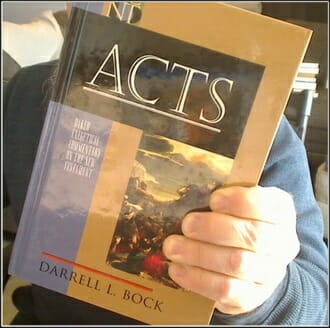
- Darrell L. Bock, Acts, Baker Exegetical Commentary on the New Testament, ECNT (Grand Rapids, MI: Baker Academic, 2007), 354-356.
9:1-2 Saul is still (ἔτι, eti) at work against the church (Acts 8:3), breathing threats and murder against its members. This is the only NT use of the term ἐμπνέω (empneō) for “breathe.” It is part of an idiom about breathing out threats and murder (BAGD 256 §1; BDAG 324 §1).’ The expression reflects Saul’s highly hostile attitude toward believers. It may not mean that he seeks to murder them himself, given that execution remains in Roman hands, but it expresses what he hopes will be the result of his arrests (22:4; 26:10; Marshall 1980: 168; Weiser 1981: 222-23). If (ἐάν, ean) he should find them, Saul would deliver them to prison, where they may well be sent on to Rome as troublemakers. The conditional clause is third class and is presented with a touch of uncer tainty (Culy and Parsons 2003: 170). It may also be that Rome already has not decided to give the Jews such authority to imprison, given the scope of the perceived problem. Saul has consented to Stephen’s death already, which indicates that he is accepting of such an outcome for Jesus’s followers (8:1).
Saul pursues the disciples even beyond Jerusalem and obtains authority for doing so (probably from Caiaphas; 22:5; 26:10). Bruce (1988a: 180) suggests that Saul models his zeal after Phinehas (Num. 25:7-13; Ps. 106:30-31), Elijah (1 Kings 18:40; 19:10, 14), and Mattathias (1 Macc. 2:23-28). The Maccabean period makes clear that religious zeal often did work its way into Jewish practice. Witherington (1998: 302-3) notes the later activism that led Rome to destroy Jerusalem in AD 70. Paul himself confesses that he was a persecutor of the church (1 Cor. 15:9; Gal. 1:13-14; Phil. 3:6; 1 Tim. 1:13).
The letters that Paul asks for concern the right of extradition, if 1 Macc. 15:21 applies. Conzelmann (1987: 71) disputes the genuineness and the relevance of the letter in 1 Macc. 15:16-21, noting that it is too far removed in time to be relevant, even if it were genuine. Barrett (1994: 446-47) has a full discussion and concludes that the more important issue is how the Sanhedrin is related to outside synagogues. Haenchen (1987: 320n2) is also skeptical of such extradition authority. Even though the Maccabean letter is old, however, it might reflect Jewish beliefs and Roman practice that continued into Paul’s time regarding religious issues. Josephus in Ant. 14.10.2 §§192-95 describes a later, parallel letter of authorization. Thus the practice appears to span Paul’s time period.
Conzelmann argues that Josephus, J. W. 1.24.2 §474, does not agree with this right of extradition, since it makes a unique claim for such authority for Herod. Conzelmann does not note, however, the Ant. 14 text, which indicates the possibility of such authorization to a Jew. Haenchen calls the Ant. 14 text irrelevant, but it does show the potential for a close relationship like the one Caiaphas had with Pilate. In addition, the subject at hand is the authority over the synagogues of Judaism, a religious-oversight issue. Since this is not so much a matter of legal execution as imprisonment, it is quite likely that the high priest and Sanhedrin had such authority and that with a letter the synagogues of the Diaspora might cooperate if it were a question of the presence of heterodoxy. That the governor under king Aretas sought to arrest Saul in Damascus (2 Cor. 11:32) is not surprising, given Saul’s turn in allegiance and the public destabilization it may well have brought (but Schille 1984: 219 is skeptical); this detail does not indicate a lack of authority of Jews over their faith in Syria (Acts 26:12; 2 Cor. 11:32-33). As a whole, then, the scenario involving letters for Paul seems credible.
Christianity has already spread as far as Damascus, an important city 135 miles north-northeast of Jerusalem. This is the first city outside the land of Israel to be noted as having Christians. Hengel and Schwemer (1997: 80-90) see it as a small community, something Saul’s own letters in verse 2 suggest by the words “might find” Christians there. They also propose that it was fleeing Jewish Christian Hellenists from Jerusalem who helped found the community, something the juxtaposition of this event with Acts 7 suggests (given that Peter and Philip went in the other direction). These Hellenists may well have pushed steadily north and shared the gospel. If so, Saul is sent to block the advance of the message.
Damascus was a commercial center on the way between Egypt and Mesopotamia. It had a substantial Jewish population.[2] The mention of Damascus is significant, for Luke has not told us anything about this church yet. In Acts the church has now moved north to Samaria (Acts 8), west and south to the coast, and east to Syria (Acts 9).
“The Way” is the early name for Christians (19:9, 23; 24:14, 22), sometimes referred to as “the way of the Lord” or “the way of God” (18:25-26).[3] It appears to point to the way of salvation as a way of and to life. Later Christian works such as Did. 1-6 may well have borrowed this metaphor in speaking of the two ways, one leading to life, the other to death. Haenchen (1987: 319n2) discusses the various names given to Christians in Acts 9: disciples, those of the Way, saints, those who call on the name of the Lord, brothers, and witnesses. Each name points out a distinct feature of what being a believer means or entails.
Saul will apprehend both men and women, as he must know that the faith is spreading among both genders (Jervell 1998: 279).
[2] Josephus, J. W. 2.20.2 §561, speaks of at least ten thousand being massacred there, but 7.8.7 §368 speaks of more than eighteen thousand killed. Both are estimates and point to a large Jewish population. On the city’s history, see Fitzmyer 1998: 423; details in Hengel and Schwemer 1997: 55-61.
[3] For a similar description at Qumran, see 1QS 9.17-18; 10.21; 11.13; CD 1.13; 2.6; 20.18. In Judaism, see 1 En. 91.18; 2 En. 30.15; T. Ash. 3.1-6.5; Ebel, NIDNTT 3:935-43; Johnson 1992: 162; Fitzmyer 1998: 424 notes multiple references at Qumran. It is also present in the OT: Pss. 1:1, 6; 2:12.
- Craig S. Keener, Acts: An Exegetical Commentary & 2: Introduction and 1:1–14:28, vol. 1 (Grand Rapids, MI: Baker Academic, 2012–2013), 1622–1626.
(4) Letters of Authorization (9:2)
Letters from Jerusalem to the Diaspora are attested over a long period.231 Official letters from a person in an office to others also in office were often posted in public locations, which made them a readily recognizable letter form.232 Here, however, the letters are letters of recommendation that Paul carries.
Those who carried letters from a high official acted on that official’s authorization (1 Esd 4:61; Neh 2:7, 9). Letters of recommendation of various sorts reflect a pervasive custom (Rom 16:1–2; 1 Cor 16:15–18; Phil 2:29–30; 4:2–3; 1 Thess 5:12–13; Phlm 8–17; Heb 13:17; 3 John 12);233 thus, for example, leaders in Jerusalem sent letters confirming Josephus in his authority (Jos. Life 310–11).234 Sometimes people of rank sent such letters for their clients or others to provide them “credentials for some activity rather than merely to introduce” them.235 In general, travelers could carry letters of recommendation so that the receiver would know to welcome them.236
Some comments about the context of recommendation letters can illustrate their general function, although many of the specific elements mentioned here (perhaps especially in formal Roman letters) would not appear in the high priest’s letters for Paul. Recommenders placed their own credibility on the line when writing such letters,237 but they socially indebted to themselves those so recommended.238 Appeal to the potential benefactor’s generosity was a natural element in many recommendation letters.239 Further, when two people shared a mutual friend, they became friends, part of the same in-group.240 The receiver of the recommendation would act on the basis of the receiver’s relationship with the recommender, and hence recommendations might spell out the beneficiary’s relationship with the recommender.241 By generosity to the beneficiary, the benefactor displayed friendship with the recommender242 and also guarded the recommender’s honor in the eyes of the beneficiary.243 When the letter’s receiver was of the same (rather than lower) social station as the recommender, the receiver might express or anticipate reciprocity for the favor done.244
Despite conventional forms, writers could prove creative in articulating reasons for receiving the recommendations.245 Powerful writers sometimes claimed that the person on whose behalf they wrote was more deserving than any other (cf. Phil 2:20) or that this beneficiary was a particularly special one—even when they had written many other such letters with superlative claims.246 They could also request that the beneficiary be treated as if the beneficiary were in fact the recommender.247 Or they could simply request that the letter recipient receive well its bearer.248 Sometimes, at least in later times, they might assert that the receiver already knew the worth of the one recommended, or that no letter was really necessary.249
Among Romans of rank, such letters were often only one250 to four paragraphs in length. At least in Egypt, the usual structure of letters of recommendation was as follows:251
- Opening
- Salutation formula
- Formula valetudinis
- Background
- Identification formula
- Background proper
- Request period
- Request clause
- Circumstantial clause
- Purpose or causal clause
- Appreciation
- Closing
- Closing formula valetudinis
- Closing salutation
The letters usually began by identifying the person recommended and designating the person’s relationship to the sender;252 for Saul, then, it would be a great honor to carry such a letter (cf. Gal 1:1, 14). Later, as an apostle “not from men” but from Christ (1:1), Paul would eschew dependence on such letters of recommendation (2 Cor 3:1–3). (Even when Paul writes recommendations in his letters, the basis differs from that in most other letters of recommendation.)254
(5) Extradition Requests Here? (9:2)
People of higher rank expected subordinates to obey their letters (e.g., 1 Kgs 21:8; Esth 1:22; 8:10; 9:20, 30; 1 Macc 1:44). But is obedience demanded here? Some scholars have argued that the high priest had extradition rights for Judean fugitives that would be respected by rulers in the region.255 This may have been true in the second century b.c.e. if we may trust our sources on this point; the Romans granted Judea extradition rights from Egypt’s ruler (1 Macc 15:21),256 [see] and Julius Caesar presumably reconfirmed these rights in 47 b.c.e. by making the high-priestly family ethnarchs over all Jews and arbiters of Jewish customs (Jos. Ant. 14.189–95). Rome also granted King Herod extraordinary rights for extraditing fugitives from the region of his jurisdiction (War 1.474, acknowledging this situation as unusual).257 [see]
In this period, however, Judea had a Roman governor.258 [see] Even if Pilate in Caesarea remained aloof from the Jerusalem aristocracy’s affairs, other governors were under no legal or political obligation to another city’s aristocracy. The letters, however, are not to local governments but, as Luke expressly claims, to synagogues (Acts 9:2).259 [see] Local Jewish communities retained rights to practice their own customs as ethnic conclaves in foreign cities;260 [see] consequently, they would be able to continue practicing disciplines in their own synagogues (Luke 21:12; Matt 10:17; 2 Cor 11:24) so long as no one renounced Judaism and complained of subsequent abuse.261 [see] Just as Alexandrian Jews had an ethnarch and Nabateans in Damascus had an ethnarch (2 Cor 11:32), Damascene Jews would possess a measure of autonomy. Most synagogue leaders would have acted out of respect for the high priest.262 [see] If conflicts arose, local municipal authorities probably would have (though need not have) chosen to defer to the rights of minority communities in disciplining their own members.263 [see] In this case, they may have secured the cooperation of other groups as well (2 Cor 11:32).
But at minimum, the letters could encourage support less forcefully, simply commending Paul (see discussion of recommendation letters, above) and authorizing his mission in more basic ways. Saul and his companions would not have the advantages of travel given to those traveling on Rome’s business,264 [see] but letters of recommendation from the high priest would guarantee them aid along the way from local Jewish communities. The objects of Saul’s quest would not be local Jewish Christians (he and his allies may well have hoped there were none) but fugitives from Jerusalem, where the high priest exercised direct civic authority.265 [see]
Synagogues appear often in Luke-Acts, but the reference to their involvement in persecution here (cf. Acts 22:19; 26:11) partly fulfills the warning of Luke 21:12: soon after Jesus’s ministry but before predicted wars and earthquakes (21:10–12), his followers would be handed over to synagogues for discipline. “Binding” free people was a terrible insult to their dignity (Polyb. 1.69.5; see comment on Acts 21:33–34). That women were also targets indicates the vicious lengths to which Saul went to eradicate the movement (cf. Val. Max. 9.2.1); see comment on Acts 8:3.
231. Bauckham, “James,” 423–24, cites the Elephantine papyri (fifth century b.c.e.) and 2 Macc 1:1–10.
232. Aune, Environment, 164–65.
233. E.g., Cic. Fam. 7.5.2–3 (with 7.6.1; 7.7.1; 7.8.1; 7.10.3); 13.1–79 (all of Fam. 13 except 13.68); Socratics Ep. 28; cf. Men. Rhet. 2.5, 397.21–24; see esp. Kim, Letter of Recommendation, passim (for nt examples, 119–20; for papyri, 150–238); also Agosto, “Conventions,” 70–117; Keyes, “Letter of Introduction”; Marshall, Enmity, 91–129, 268–71; more briefly, Stowers, Letter Writing, 153–65; Aune, Environment, 166–67; Malherbe, Social Aspects, 102; Keener, Corinthians, 166–67.
234. For a later rabbinic example, see, e.g., y. Moʾed Qaṭ. 3:1, §2.
235. Stowers, Letter Writing, 153. Writers normally interceded for the third party to establish his positive relationship with the receivers or secure him some other favor with them (ibid., 155); they also often identify the sender with the one recommended (Malherbe, Social Aspects, 102–3, citing P.Oslo 55).
236. E.g., Lucian Lucius 2.
237. E.g., Pliny Ep. 2.9.2. Although writing many letters, Cicero assures his receiver that he is sensitive to his reputation and thus does not recommend indiscriminately (Fam. 13.48.1). Thus some letters are worded more cautiously (e.g., Symm. Ep. 1.72).
238. E.g., Pliny Ep. 2.13.9; 3.2.6; 3.8.2.
239. E.g., Cic. Fam. 13.44.1; Pliny Ep. 10.4.1; 10.94.3; 10.120.2; Phlm 14.
240. Malina, Windows, 48.
241. E.g., P.Oxy. 292; Cic. Fam. 13.3.1; 13.5.3; 13.44.1; Dio Chrys. Ep. 2; Pliny Ep. 2.13.7, 10; 3.2.4; 7.16.5; 10.4.1, 4; 10.5.1; 10.11.1; 10.87.1; 10.94.1; Fronto Ad Ant. Pium 9.2. For the papyri, see further Kim, Letter of Recommendation, 37–42. Cf. the recommendee’s readiness to depend on the recommender’s relationship with the receiver of the letter (e.g., Symm. Ep. 1.70; 1.81; 1.106; 1.107).
242. So explicitly in Pliny Ep. 10.4.6; see also Symm. Ep. 1.30; 1.71. In some parts of the world today, such social demands lead to considerable corruption; this was true in Rome as well, but ethical constraints did impose some limitations.
243. E.g., Cic. Fam. 1.3.2. Cicero’s letters of recommendation often ask the benefactor to prove to the recommended person how good a recommendation Cicero had written on the recommended one’s behalf and how influential Cicero had been for good (e.g., Cic. Fam. 13.19.3; 13.20.1; 13.26.4; 13.30.2; 13.35.2; 13.36.2; 13.44.1; 13.45.1; 13.46.1; 13.49.1; 13.58.1; 13.77.2; 13.78.2); cf. also Symm. Ep 1.93; 1.106. For correspondents proving their love, cf., e.g., Symm. 1.14.1; 1.27; 1.43.2; 1.87; 1.98; 2 Cor 8:24.
244. E.g., Pliny Ep. 2.13.1–2; 3.2.1; 4.4.2–3; 7.31.7. If the letter receiver’s status was less, the receiver would respond especially with gratitude (Fronto Ad Ant. Pium 9.1). Gratitude was critical, both for the recommender and for the beneficiary (e.g., Cic. Fam. 13.3.1; Pliny Ep. 4.12.1, 5–7).
245. E.g., Pliny Ep. 3.3.5; 6.8.1–2, 5. Articulating reasons was essential (Dio Chrys. Ep. 1; esp. Pliny Ep. 2.13.11).
246. E.g., Cic. Fam. 3.1.3; 13.1.5; 13.5.3; 13.18.2; 13.19.1; 13.26.1; 13.32.2; 13.34.1; 13.35.1; 13.36.1–2; 13.39.1; 13.45.1; 13.51.1; 13.78.2.
247. E.g., P.Oxy. 32; Cic. Fam. 13.5.3; cf. 1 Cor 16:10; Phlm 17; Kim, Letters of Recommendation, 7, 37–42.
248. See, e.g., P.Grenf. 2.77.34–38 (from the third or fourth century c.e.). Officials could also use public recommendations to commend their friends (e.g., P.Lond. 1912.105–8).
249. E.g., Symm. Ep. 1.22; 1.67; 1.75; 1.81. In Ep. 1.63, Symmachus claims that he recommends one for the letter receiver’s benefit; in Ep. 1.94, he hopes his letter adequate to communicate the recommendee’s merits; in Ep. 1.104, the recommendee is better than the letter is able to convey.
250. For one paragraph, see, e.g., Cic. Fam. 13.45–49.
251. Kim, Letter of Recommendation, 7 (mostly using his words). Paul’s letters do not share this form (128), but most Christian letters of recommendation from Egypt do (99–118); for the eighty-three letters that Kim analyzed, see 156–238.
252. Ibid., 37–42.
253. Paul does send his own recommendations, usually embedded in larger letters; see ibid., 120; Agosto, “Paul and Commendation,” esp. 110–28. But like some philosophers (Diogenes Ep. 9; Epict. Diatr. 1.9.27, 33–34; 2.3.1–2; cf. 4.12.12), he did not want to depend on them for himself.
254. See esp. Agosto, “Paul and Commendation,” 127: Paul commends especially on the basis of work in the church rather than of social connections. But even with Paul, such connections remain; e.g., Rom 16:2; Phil 2:22, 30; Phlm 10–13.
255. E.g., Reicke, Era, 149; Bruce, Apostle, 72.
256. Bruce, Apostle, 72, noting that the author Lucius (1 Macc 15:16) is presumably Lucius Caecilius Metellus, consul in 142 b.c.e. Not all accept as certain the document’s authenticity (Wallace and Williams, Acts, 52, who favor unofficial action here).
257. Bruce, Apostle, 72; idem, Commentary, 193; Johnson, Acts, 162 (providing the information but not committed to the conclusion). Cities normally agreed to extraditions only if they were on good terms (Livy 41.23.1–5; Dio Chrys. Or. 38.41–42).
258. Some argue that Damascus may not have even been under direct Roman rule in this period (see Barrett, Acts, 446); for further discussion, see excursus on Nabateans at Acts 9:23.
259. With Barrett, Acts, 446. Haenchen, Acts, 320–21n3, has therefore misread Acts (in averring that Luke read the Maccabean situation into it) no less than its attempted defenders above. For influential festal letters uniting Jewish communities, see Whitters, “Observations” (citing Esth 9:20–32; 2 Macc 1:1–9; 1:10–2:18; Elephantine’s “Passover Papyrus”; and later 2 Bar. 78–87); for some early encyclical letters from sages, see Aune, Environment, 185.
260. E.g., Jos. Ant. 14.213–16, 223, 227, 242, 245–46, 258, 260, 263; 16.162–65; see discussion in Sanders, Judaism, 212; Rabello, “Condition”; Rajak, “Charter.”
261. For a discussion of proper scourgings as outlined in m. Mak. 3, cf. Gallas, “Fünfmal.”
262. Many scholars doubt that the high priest exercised authority over other Diaspora Jews; others argue the contrary (Bruce, Commentary, 193) or against doubting Luke without firm evidence (Munck, Acts, 81). I doubt that the high priest had in the Diaspora any legal authority recognized by the empire; nevertheless, the effectiveness of the temple tax (Jos. Ant. 18.312) and the biblical and Maccabean roles for the high priesthood indicate the respect and influence that he commanded (rightly, Dunn, Acts, 120–21; Witherington, Acts, 316; Haenchen, Acts, 71). Nevertheless, later rabbinic arguments about the Sanhedrin’s Diaspora influence (m. Mak. 1:10, cited in Rapske, Custody, 101; t. ʿOr. 1:8; Sanh. 3:10; Sipre Deut. 59.1.2; 188.1.2; perhaps y. B. Qam. 4:1, §3; Giṭ. 5:6, §3; cf. negative relations in t. ʿAbod. Zar. 4:6) are uncertain for their own period and certainly cannot be retrojected into Paul’s (see Keener, John, 212–13). And even later rabbis allowed courts outside the land (t. Sanh. 3:10).
263. This may have been especially the case if Damascus’s minority communities had influential ethnarchs, as at least the Nabateans seem to have had; see comment on Acts 9:23–24. Cf. Campbell, Deliverance, 147: “With the permission of the local authorities, the Jerusalem authorities could have claimed jurisdiction over Jews in other regions.… Moreover, the ‘letters’ in question may have been ‘requests’ rather than ‘orders’ and Luke a little hyperbolic at this point.”
264. On which see Casson, Travel, 188; cf. 197. Paul’s companions could have been Levite police delegated to him (e.g., Lenski, Acts, 357) but may have simply been other young and zealous members of the Hellenist synagogue (6:9) who shared his commitments.
265. With, e.g., Lake and Cadbury, Commentary, 100. It is possible that these events occur before the Samaritan and Gentile conversions in Acts 8 and hence too early for many local conversions to have occurred; otherwise, they may occur only shortly later.

Josephus Fixed by History/Historians
- Above video description: Scholar and historian Chris Forbes shows why Josephus is still a reliable source on the historical Jesus despite what atheists and pseud-historians say.
Via Reformed Apologetics and CARM:
The following quote has the passages that are rejected as additions (italicized) by a Christian scribe in a later Latin transcription of Josephus:
- “Around this time there lived Jesus, a wise man, if indeed one ought to call him a man. For he was one who did surprising deeds, and a teacher of such people as accept the truth gladly. He won over many Jews and many of the Greeks. He was the Messiah. When Pilate, upon hearing him accused by men of the highest standing among us, had condemned him to be crucified, those who in the first place came to love him did not give up their affection for him, for on the third day, he appeared to them restored to life. The prophets of God had prophesied this and countless other marvelous things about him. And the tribe of Christians, so called after him, have still to this day not died out.”
And here is a 10th Century Arabic transcription from an earlier Greek copy:
- “At this time there was a wise man who was called Jesus. And his conduct was good, and he was known to be virtuous. And many people from among the Jews and the other nations became his disciples. Pilate condemned him to be crucified and to die. And those who had become his disciples did not abandon his discipleship.They reported that he had appeared to them after his crucifixion and that he was alive; accordingly, he was perhaps the Messiah concerning whom the prophets have recounted wonders.” (This version will be lost to scholarship until 1971)
For a chronological look at the text and it’s evolving historical significance, see: The Mystery of the Testimonium Flavianum
- Above video description: Historians and scholars show that Josephus is a reliable historian on the historical Jesus despite the interpolations.
Again, here is the fixed version most historians accept…
- “At that time there appeared Jesus, a wise man. For he was a doer of startling deeds, a teacher of people who receive truth with pleasure. And he gained a following both among many Jews and among many of Greek origin. And when Pilate, because of an accusation made by the leading men among us, condemned him to the cross, those who had loved him previously did not cease to do so. And up until this very day the tribe of Christians (named after him) has not died out”
…from this and Josephus’ other passage…
- “Festus was now dead, and Albinus was but upon the road; so he assembled the sanhedrin of judges, and brought before them the brother of Jesus, who was called Christ, whose name was James, and some others; and when he had formed an accusation against them as breakers of the law, he delivered them to be stoned”
With the passage from Josephus fixed, and including his other history concerning that time/area — what do we know?
1. He existed as a man. The historian Josephus grew up in a priestly family in first-century Palestine and wrote only decades after Jesus’ death. Jesus’ known associates, such as Jesus’ brother James, were his contemporaries. The historical and cultural context was second nature to Josephus. “If any Jewish writer were ever in a position to know about the non-existence of Jesus, it would have been Josephus. His implicit affirmation of the existence of Jesus has been, and still is, the most significant obstacle for those who argue that the extra-Biblical evidence is not probative on this point,” Robert Van Voorst observes.32 And Tacitus was careful enough not to report real executions of nonexistent people.
2. His personal name was Jesus, as Josephus informs us.
3. He was called Christos in Greek, which is a translation of the Hebrew wordMessiah, both of which mean “anointed” or “(the) anointed one,” as Josephus states and Tacitus implies, unaware, by reporting, as Romans thought, that his name was Christus.
4. He had a brother named James (Jacob), as Josephus reports.
5. He won over both Jews and “Greeks” (i.e., Gentiles of Hellenistic culture), according to Josephus, although it is anachronistic to say that they were “many” at the end of his life. Large growth
in the number of Jesus’ actual followers came only after his death.
6. Jewish leaders of the day expressed unfavorable opinions about him, at least according to some versions of the Testimonium Flavianum.
7. Pilate rendered the decision that he should be executed, as both Tacitus and Josephus state.
8. His execution was specifically by crucifixion, according to Josephus.
9. He was executed during Pontius Pilate’s governorship over Judea (26–36 C.E.), as Josephus implies and Tacitus states, adding that it was during Tiberius’s reign.
(Via Tektonics AND Biblical Archaeology)
Even atheist agree:

Fact-Checking Sam Harris ~ Acts17Apologetics
Video Description:
Sam Harris recently said that he wants to correct every error he’s ever made, and that people should send him any errors they find in his works. One of Sam’s errors was made on “The Colbert Report,” where he insisted that, according to the Quran, anyone who believes in the virgin birth of Jesus will spend eternity in hell. Since Islam affirms the virgin birth of Jesus, we can only wonder how much Sam really knows about the religions he discusses in his books.
UPDATE: Sam Harris responded: “I meant that Quran asserts Jesus wasn’t divine. I misspoke.” Odd to give a reply about Jesus’ deity when Colbert was talking about the virgin birth, but it’s entirely possible to misspeak while the cameras are rolling and you don’t have much time to think about what you’re saying.
Video Description:
Sam Harris claims that Jesus ordered his followers to kill his enemies in Luke 19:27. But is this what the text says? Only if we ignore the fact that the command is part of a story that Jesus is telling, and that it’s a king in the story who issues this command. Can we take the leaders of the “new atheist” movement seriously when they make such blunders? David Wood answers.

Does the Bible Support Rape? Deuteronomy 22:28-29
The quick commentary on this swath of Scripture is this:
Concerning the non-virgin bride, there is an element of fraud here. A woman who admitted she was not a virgin was immune from prosecution; only one who pretended to be a virgin bride was subject to execution, and even then, only if her husband accused her. Furthermore, if any man seduced her prior to her betrothal, she needed only publicly confess this fact, and she could require him to marry her and never divorce her. If she was raped in the city, her cries for help would vindicate her. If she was raped in the field, she was presumed innocent and would be vindicated by her own words. Under those circumstances, it is quite reasonable that a woman who married under false claim of virginity was presumed to be guilty of adultery, that is, having sexual relations with someone other than her betrothed during her betrothal.
While this is a response to a particular “meme,” I will be bringing in previous discussions, posts, and ideas to build to a response that should be instructive in approaching other verses or challenges often given to the Christian as evidence that the Bible shows an “evil” God, and thus undermines the Christians reliance on the Bible.
If you want to just go to a refutation of the meme and skip the build-up, you can do so by CLICKING HERE. Otherwise, enjoy the tour through other challenges that end up being the opposite of the claims of the skeptics.
If a man encounters a young woman, a virgin who is not engaged, takes hold of her and rapes her, and they are discovered, the man who raped her must give the young woman’s father 50 silver shekels, and she must become his wife because he violated her. He cannot divorce her as long as he lives. (Deuteronomy 22:28-29)
- Intro To Topic
- Rules of Engagement
- Example One
- Example Two
- Comments On Examples
- Afterthought ~ Naturalism Cannot Define Something As “Moral”
- Question and Answer
- Backtracking A Bit
- Continuing
- A Real Question
- Context is King!
- Actually, A Compassionate Law
- Conclusion To Question One
- A 2nd Good Challenge
- Recommended Resources
- AFTER Discussion
INTRO
The meme [upper/right] was posted by my son to engender deeper conversation on his Facebook. I began to post a series of responses giving hints to ways to approach ancient documents. One must REMEMBER this as you read… I am not showing the divine nature of the Bible… I am merely pointing out the generally accepted rules of engagement when approaching ancient literature most legal systems in the West and literary critics accept as a guideline[s] to sift through documents [ancient or new]. These rules are not meant to prove the divine nature of anything. They are however meant to engender a level playing field (if-you-will) to help anyone approach weighty subjects, texts, and the like.
By using these “rules of engagement” we will find that the typical atheist/skeptic who refuses to mature in their approach to these issues use shallow thinking by promoting such “challenges,” so-called. The real purpose of such memes are merely to produce an emotional — visceral — reaction, emotive in nature, having nothing to do with good thinking in any way.
This approach, then, not only makes it easy for the believer to show the folly in such positions, BUT SHOULD make the skeptic pause and contemplate how they are making themselves look in a public place. They [the skeptic] should want to make their case full of gravitas, facts, context, and the like so they can garner a level of respect in their own positions. These memes do just the opposite. They make the skeptic look childish.
(As an aside, almost all of the graphics/pics inserted in my posts will be linked to similarly contextual article or posts.)
This is key:
Raising one’s self-consciousness [awareness] about worldviews is an essential part of intellectual maturity…. The right eyeglasses can put the world into clearer focus, and the correct worldview can function in much the same way. When someone looks at the world from the perspective of the wrong worldview, the world won’t make much sense to him. Or what he thinks makes sense will, in fact, be wrong in important respects. Putting on the right conceptual scheme, that is, viewing the world through the correct worldview, can have important repercussions for the rest of the person’s understanding of events and ideas…. Instead of thinking of Christianity as a collection of theological bits and pieces to be believed or debated, we should approach our faith as a conceptual system, as a total world-and-life view.
Ronald H. Nash, Worldviews in Conflict: Choosing Christianity in a World of Ideas (Grand Rapids, MI: Zondervan, 1992), 9, 17-18, 19.
Okay then, I will cut’n’paste much of the posts/discussion from my son’s Facebook below (with some editing/addition).
RULES OF ENGAGEMENT
This is one reason why people who say they are skeptics really are not all that skeptical… because they do not do the yeoman’s work to know how to accept or reject their own beliefs well nor those beliefs of whom they are challenging. It does a great disservice to themselves AS WELL as others… and really shows a disregard for a world religion that I have not seen shown to the other great religions of the world. Some even will defend these other Religions without knowing the religions own stated positions.
This is the first of a few points I will make.
This is an issue that has many depths to it. And when atheists or skeptics reject the Bible for such verses, they do a disservice to good thinking. And mind you, one of the most important aspects of this debate is how do we approach ancient texts in a fair way. FIRST and FOREMOST, the idea that the writers of the Bible were robotic in their transmission, called in occultism, “automatic writing,” is not what we see here – where the writer gives over control of himself to write [word-for-word] what is being relayed to him or her. Geisler so aptly words the issue this way:
The [biblical authors] who wrote Scripture were not automatons. They were more than recording secretaries. They wrote with full intent and consciousness in the normal exercise of their own literary styles and vocabularies. The personalities of the [biblical authors] were not violated by a supernatural intrusion. The Bible which they wrote is the Word of God, but it is also the words of men. God used their personalities to convey His propositions. The [biblical authors] were the immediate cause of what was written, but God was the ultimate cause.
(See references for this and Aristotle quote to follow, here)
So the idea that the Bible is a word-for-word dictum is NOT the case. The idea that the Bible is not something akin to “automatic writing” has no bearing on if this is the Divine Word of God however. Rather, the Christians concern should be to show the viable nature of the Bible in its internal context. There are techniques to help the truth seeker to do just that. In fact, our courts today incorporate some help in how they approach documents submitted as evidence, and literary-textual critics employ these Grecian helps that Aristotle and others formulated well.
The internal test utilizes one Aristotle’s dictums from his Poetics. He said,
They [the critics] start with some improbable presumption; and having so decreed it themselves, proceed to draw inferences, and censure the poet as though he had actually said whatever they happen to believe, if his statement conflicts with their notion of things…. Whenever a word seems to imply some contradiction, it is necessary to reflect how many ways there may be of understanding it in the passage in question…. So it is probably the mistake of the critics that has given rise to the Problem…. See whether he [the author] means the same thing, in the same relation, and in the same sense, before admitting that he has contradicted something he has said himself or what a man of sound sense assumes as true.
So are there rules that apply to approaching subjects in a fashion that maximizes the best conclusion on the text/topic that is the subject? Yes there is, this list is also from the Greeks and is summed up in these 8-points are summed up well in a short handout to a class I taught at church dealing with how believers should approach Scripture:
1) Rule of Definition: Define the term or words being considered and then adhere to the defined meanings.
2) Rule of Usage: Don’t add meaning to established words and terms. Ask what was the common usage in the culture at that time period.
3) Rule of Context: Avoid using words out of context. Context must define terms and how words are used.
4) Rule of Historical background: Don’t separate interpretation from historical investigation.
5) Rule of Logic: Be certain that words as interpreted agree with the overall premise.
6) Rule of Precedent: Use the known and commonly accepted meanings of words, not obscure meanings for which there is no precedent.
7) Rule of Unity: Even though many documents may be used there must be a general unity among them.
8) Rule of Inference: Base conclusions on what is already known and proven or can be reasonably implied from all known facts.
(These are more fully explained in the outline I wrote for that teaching here)
This is always helpful to the believer to fall back on when skeptics take a single Scripture out of context and uses it as an example of why they reject the Bible. (The same would be said if something was done in similar fashion to such works as Homer’s Iliad, Caesar’s Gallic Wars, a play from Shakespeare, or the like.) These people not only try to show the Bible in a certain light, but take a leap to say Scripture is not divine in how the Christian or Jew think it is. This is a leap that the text does not warrant. Again, the conclusion they make is not warranted by properly approaching the text… in other words they destroy any warrant they feel they have or have shown by sloppy thinking. By creating this “straw-man” they come to a conclusion that is really a non-sequitur, effectively making their position incoherent.
I will talk about two such texts in the next post.
EXAMPLE ONE
Over the years I have been challenged with many verses. While I have responded to this in the past, Dennis Prager’s critiques is hard to beat. This challenge has to do with Deuteronomy 21:18-21. The Scripture and argument go something like this:
“If any man has a stubborn and rebellious son who will not obey his father or his mother, and when they chastise him, he will not even listen to them, 19 then his father and mother shall seize him, and bring him out to the elders of his city at the gateway of his home town. 20 “And they shall say to the elders of his city, ‘This son of ours is stubborn and rebellious, he will not obey us, he is a glutton and a drunkard.’ 21 “Then all the men of his city shall stone him to death; so you shall remove the evil from your midst, and all Israel shall hear of it and fear,” (Deut. 21:18-21).
BEFORE getting to Prager’s rebuttal… let us deal with some qualifications one need to know and apply to a text in order to maximize a skeptical look at said text.
This seemingly harsh punishment for rebellion has been used by the critics of Christianity to infer the moral backwardness of Old Testament ethics. It is easy to throw stones from the comfort of our 21st-century perspective. If you apply our own understanding to this situation… then yes, I would agree with the skeptic. But this is not how thoughtful people approach ancient texts. For instance… there are many gaps from our 21st-Century post Judeo-Christian, Western culture that one should account for.
THE LANGUAGE GAP
✦ …Consider how confused a foreigner must be when he reads in a daily newspaper: “The prospectors made a strike yesterday up in the mountains.” “The union went on strike this morning.” “The batter made his third strike and was called out by the umpire.” “Strike up with the Star Spangled Banner.” “The fisherman got a good strike in the middle of the lake.” Presumably each of these completely different uses of the same word go back to the parent and have the same etymology. But complete confusion may result from misunderstanding how the speaker meant the word to be used…. We must engage in careful exegesis in order to find out what he meant in light of contemporary conditions and usage.
We speak English, but the Bible was written in Hebrew and Greek (and a few parts in Aramaic, which is similar to Hebrew). Therefore, we have a language gap; if we don’t bridge it, we won’t fully be able to understand the Bible.
THE CULTURE GAP
If we don’t understand the various cultures of the time in which the Bible was written, we’ll never comprehend its meaning. For example, if we did not know anything about the Jewish culture at the time of Christ, the Gospel of Matthew would be very difficult to grasp. Concepts such as the Sabbath, Jewish rituals, the temple ceremonies, and other customs of the Jews must be under¬stood within cultural context in order to gain the true meaning of the author’s ideas.
THE GEOGRAPHY GAP
A failure to be familiar with geography will hinder learning. For instance, in I Thessalonians 1:8 we read, “For from you sounded out the word of the Lord not only in Macedonia and Achaia, but also in every place your faith [toward] God is spread abroad.” What is so remarkable about this text is that the message traveled so quickly. In order to understand how, it is necessary to know the geography.
Paul had just been there, and when he wrote the letter, very little time had passed. Paul had been with them for a couple of weeks, but their testimony had already spread far. How could that happen so fast? If you study the geography of the area you’ll find that the Ignatian Highway runs right through the middle of Thessalonica. It was the main concourse between the East and the West, and whatever happened there was passed all the way down the line.
THE HISTORY GAP
Knowing the history behind a passage will enhance our comprehension of what was written. In the Gospel of John, the whole key to understanding the interplay between Pilate and Jesus is based on the knowledge of history.
When Pilate came into the land with his emperor worship, it literally infuriated the Jews and their priests. So he was off to a bad start from the very beginning. Then he tried to pull something on the Jews, and when they caught him, they reported him to Rome, and he almost lost his job. Pilate was afraid of the Jews, and that’s why he let Christ be crucified. Why was he afraid? Because he already had a rotten track record, and his job was on the line.
Consider something known as the psychology of testimony. This refers to the way witnesses of the same event recall it with a certain level of discrepancy, based on how they individually observe, process, store, and retrieve the memories of an event.
One person may recall an event in strict chronological order; another may testify according to the principle of the association of ideas. One person may remember events minutely and consecutively, while someone else omits, condenses, or expands. These factors must be considered in comparing eyewitness accounts, and this is why history expects a certain amount of variability in human testimony. For example, let’s say that twelve eyewitnesses observed the same event–a car accident. If those witnesses were called to testify in a court of law, what would the judge think if all twelve witnesses gave the same exact testimony of the event, with every detail being identical? Any good judge would immediately conclude they were in collusion and reject their accounts. The variations of the observations of the eyewitness testimonies actually add to the integrity of their recall.
These are just a few of the many examples one needs to seriously consider when approaching ANY ancient text – especially ancient religious texts.
GENRE (IN THE OLD TESTAMENT)
- Law is “God’s law,” they are the expressions of His sovereign will and character. The writings of Moses contain a lot of Law. God provided the Jews with many laws (619 or so). These laws defined the proper relationship with God to each others and the world (the alien)….
- History. Almost every OT book contains history. Some books of the Bible are grouped together and commonly referred to as the “History” (Joshua, Kings & Chronicles). These books tell us the history of the Jewish people from the time of the Judges through the Persian Empire…. In the NT, Acts contains some of the history of the early church, and the Gospels also have History as Jesus’ life is told as History….
- Wisdom Literature is focus on questions about the meaning of life (Job, Ecclesiastes), practical living, and common sense (Proverbs and some Psalms )….
- Poetry is found mostly in the Old Testament and is similar to modern poetry. Since it is a different language, “Hebrew,” the Bible’s poetry can be very different, because it does not translate into English very well….
- Prophecy is the type of literature that is often associated with predicting the future; however, it is also God’s words of “get with it” or else. Thus Prophecy also exposes sin and calls for repentance and obedience. It shows how God’s law can be applied to specific problems and situations, such as the repeated warnings to the Jews before their captivity….
- Apocalyptic Writing is a more specific form of prophecy. Apocalyptic writing is a type of literature that warns us of future events which, full meaning, is hidden to us for the time being….
(Source)
Approaching portions of Scripture (or ANY ancient text) knowing even the genre is helpful to dissect it well.
DENNIS PRAGER exemplifies how to approach Deuteronomy 21:18-21 by explaining much of what we have talked about already plus more:
Moving on…
EXAMPLE TWO
In an ongoing discussion at an atheist’s website, I was challenged with how evil God is to kill children with a Bear (2 Kings 2:23-25). I mean children? Here we have proof that God killed innocent children. Or so a light reading would express as much.
This is a post I can truly pat-myself-on-the-back for… because I offered a twist on this that other apologists have not. Let me explain after this verse is read:
He went up from there to Bethel, and while he was going up on the way, some small boys came out of the city and jeered at him, saying, “Go up, you baldhead! Go up, you baldhead!” And he turned around, and when he saw them, he cursed them in the name of the LORD. And two she-bears came out of the woods and tore forty-two of the boys. From there he went on to Mount Carmel, and from there he returned to Samaria. (2 Kings 2:23-25)
It looks like we are seeing God killing kids for essentially – and just as cutely – as a young child gets frustrated and calls a friend “poopy head.”
However, if you come at this ancient text taking the Grecian examples of the credibility afforded a text, and step out of our 21st-Century post Judeo-Christian “Western” culture and ask if there are gaps in our knowledge (historical time periods, who was this written to, who wrote it, does understanding geography help us in understanding this tough verse, does understanding the culture of the writer help [how are the two cultures different], are there hint in the Hebrew that will help us as well, etc) Using this we can ask like any CSI detective:
- Who;
- What;
- When;
- Where;
- Why;
- And How It Happened.
…as well as does the text…
- Emphasize something;
- Does it repeat a theme in the larger text;
- Is it related or unrelated;
- Is it alike or similar to other portions of the text or cultures in the area;
- Is it true to our modern life in some way.
By doing so we can find out that:
✔ The crowd was in their late teens to early twenties (NOT CHILDREN, but military age, and this is known from other parts of the Bible where the Hebrew is used AS WELL AS from other ancient documents and cultures in the area of the Middle-East);
✔ they were antisemitic (this is known from most of the previous passages and books as well – also historical anthropology and other ancient texts);
✔ they were from a violently cultic city (ditto);
✔ the crowd was large (large enough to do the following….
(Here is my “pat-on-the-back” coming up)
✔ this large crowd had already turned violent and riotess.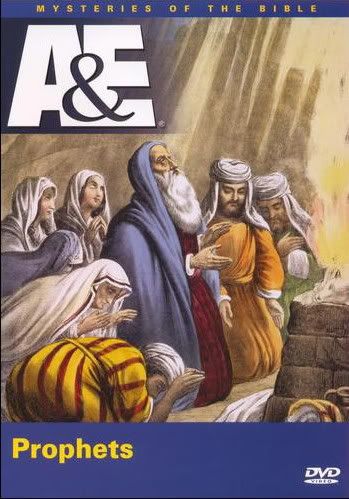
I can say this because as the pictures of cultural customs from this time-period [key!] show on my in-depth response to this by using drawings of historical figures from Israels history: priests, prophets, spiritual leaders, and even Flavius Josephus.
What did you notice above in the cover to an A&E documentary to the right? Yup, a turban as well as a cloak which covers the heads of the priests and prophets. Take note of the below as well.





I will post continue with a snippet from the aforementioned post:
I posted multiple images to drive a point home in our mind. The prophet Elisha would have had a couple cultural accoutrements that changes this story from simple name calling to an assault. He wouldn’t have been alone either, in other words, he would have had some people attached to him that would lay down their lives to protect him. And secondly, he would have had a head covering on, especially since he was returning from a “priestly” intervention. So we know from cultural history the following:
- He would have had a head dressing on — some sort of turbin; and he would have had an entourage of men to dissuade any attack or mistreatment of a priest of Israel on a journey.
One last point before we bullet point the complete idea behind the Holy and Rightful judgement from the Judge of all mankind. There were 42 persons killed by two bears. Obviously this would require many more than 42 people. Why? What happens when you have a group of ten people and a bear comes crashing out of the bushes in preparation to attack? Every one will immediately scatter! In the debate I pointed out that freezing 42 people and allowing the bears time to go down the line to kill each one would be even more of a miracle than this skeptic would want to allow. So the common sense position would require a large crowd and some sort of terrain to cut off escape. So the crowd would probably have been at least a few hundred.
Also, this holy man of God was coming back from a “mission,” he would have had an entourage with him ~ as already mentioned, as well as having some sort of head-covering on as pictured above ~ as already mentioned.
QUESTION: ANSWER:
So, what do these cultural and historical points cause us to rightly assume?
That the crowd could not see that the prophet was bald.
Which means they would have had to of gotten physical — forcefully removing the head covering. Which means also that the men with the prophet Elisha would have also been overpowered. So lets bullet point the points that undermine the skeptics viewpoint.
✔ The crowd was in their late teens to early twenties;
✔ they were antisemitic (this is known from most of the previous passages and books);
✔ they were from a violently cultic city;
✔ the crowd was large;
✔ the crowd had already turned violent.
These points caused God in his foreknowledge to protect the prophet and send in nature to disperse the crowd. Nature is not kind, and the death of these men were done by a just Judge. This explains the actions of a just God better than many of the references I read.
Your welcome.
COMMENT AFTER THE TWO EXAMPLES
So when I see something like this meme… it is just that. A very badly “exegeted” point. VERY RARELY do I meet a skeptic that does the yeoman’s work of heavy lifting and making a case well enough that they explain their disbelief in a manner that would demand a decision by other’s by engendering an informed dialogue. But this is why Trump — pivoting here to make a point — does so well among conservative because rather than pausing to see if their emotional response is rooted in more that a rejection based on “no-knowledge” and driven by reactive feeling to the opposing political party.
This is how Obama was elected as well.
Skpetics and liberal leaning persons deride the religious or conservative folks for being shallow and not thinking well, but in fact these rejections of BIG IDEAS and ancient text are done by doing just that — low information positions. which is why I ask people to pause and to think more deeply on their own positions. To learn their position better as well as to know better without making straw-men type arguments the position they are rejecting. In-other-words, Know what you reject, and why you reject it.
AGAIN, bringing this to current examples in our political lives, and repeating myself in a way:
Very rarely do you find someone who is an honest enough skeptic that after watching the above 3 short videos asks questions like: “Okay, since my suggestion was obviously false, what would be the driving presuppositions/biases behind such a production?” “What are my driving biases/presuppositions that caused me to grab onto such false positions?” You see, few people take the time and do the hard work to compare and contrast ideas and facts. A good example of this is taken from years of discussing various topics with persons of opposing views, I often ask if they have taken the time to “compare and contrast.” Here is my example:
I own and have watched (some of the below are shown in high-school classes):
- Bowling for Columbine
- Roger and Me
- Fahrenheit 9/11
- Wal-Mart: The High Cost of Low Price
- Sicko
- An Inconvenient Truth
- Loose Change
- Zeitgeist
- Religulouse
- The God Who Wasn’t There
- Super-Size Me
But rarely [really never] do I meet someone of the opposite persuasion from me that have watched any of the following (I own and have watched):
- Celsius41.11: The Temperature at Which the Brain Dies
- FahrenHYPE 9/11
- Michael & Me
- Michael Moore Hates America
- Bullshit! Fifth Season… Read More (where they tear apart the Wal-Mart documentary)
- Indoctrinate U
- Mine Your Own Business
- Screw Loose Change
- 3-part response to Zeitgeist
- Fat-Head
- Privileged Planet
- Unlocking the Mystery of Life
AFTERTHOUGHT
Just as an afterthought. A skeptic who rejects God and accepts naturalism cannot say rape is wrong like the theist can say this:
RAPE:
- theism: evil, wrong at all times and places in the universe — absolutely;
- atheism: taboo, it was used in our species in the past for the survival of the fittest, and is thus a vestige of evolutionary progress… and so may once again become a tool for survival — it is in every corner of nature;
- pantheism: illusion, all morals and ethical actions and positions are actually an illusion (Hinduism – maya; Buddhism – sunyata). In order to reach some state of Nirvana one must retract from this world in their thinking on moral matters, such as love and hate, good and bad. Not only that, but often times the person being raped has built up bad karma and thus is the main driver for his or her state of affairs (thus, in one sense it is “right” that rape happens).
An example from an “evangelical” atheist:
★ Richard Dawkins: My value judgement itself could come from my evolutionary past.
★ Justin Brierley: So therefore it’s just as random in a sense as any product of evolution.
★ Richard Dawkins: You could say that, it doesn’t in any case, nothing about it makes it more probable that there is anything supernatural.
★ Justin Brierley: Ultimately, your belief that rape is wrong is as arbitrary as the fact that we’ve evolved five fingers rather than six.
★ Richard Dawkins: You could say that, yeah.
In other words they have to BORROW FROM ethics the worldview that they are trying to disprove.
For more on this, see my post noting many more atheist/evolutionary (philosophical naturalism) positions followed to their logical conclusions here:
QUESTION REGARDING THE ORIGINAL MEME
Here are some questions from a person trying to figure out what I have been getting at. At first they seem like “snarky” comments, but end up in a good honest question.
S.C. said:
So when you say rape was “okay then and not now”, you mean that it was ok according to the people, or according to God? (Or both?)
I say this is snarky because the questioner either was not aware (or on purpose) formulated the question which would only allow for a response that “damned” the responder.
In a very neat book meant to dumb down big ideas in logic, we read the following example that will surely persuade the reader who dislike “Dubya’s” rhetoric:
A false dilemma is an argument that presents a limited set of two possible categories and assumes that everything in the scope of the discussion must be an element of that set. Thus, by rejecting one category, you are forced to accept the other. For example, “In the war on fanaticism, there are no sidelines; you are either with us or with the fanatics.” In reality, there is a third option, one could very well be neutral; and a fourth option, one may be against both; and even a fifth option, one may empathize with elements of both.
Ali Almossawi, An Illustrated Book of Bad Arguments: Learn the Lost Art of Making Sense (New York, NY: The Experiment, 2013), 16.
To backtrack just a bit, I am sure S.C. missed the previous two point response to the meme specifically in the original post on Facebook. So I will post these here for clarity and then pick back up with the convo
Back Tracking
I linked to a post on Dr. William Lane Craig’s Reasonable Faith site explaining some of the issues. Here is an excerpt of the challenge… followed by an excerpt of the response:
…you believe that the Bible is the revealed word of God, as you seem to regarding the existence of Jesus of Nazareth, then how do you find child rape so abhorrent when there is nothing in the Bible condemning it? Indeed, Deuteronomy 22:28-29 NLT says that if a woman (regardless of age) is raped, the rapist must pay her father 50 silvers and marry the woman, which hardly seems a punishment to the rapist. This, of course, excludes engaged women, for whom the punishment for being raped is death if they don’t cry for help (Deuteronomy 22:23-24 NAB). The only instance in which it is only the rapist who is punished is if the victim is engaged (possible but not likely if they are a child), and they cry for help (again, a child would very likely be intimidated into not calling for help, and therefore, by Biblical law, be killed)….
Dr. Craig responds in full, but here is the point I wish to zero in on:
Moral Argument – The Old Testament as a sufficient framework for morality
But do your examples even do that? The immorality of rape is immediately given in the seventh of the Ten Commandments “You shall not commit adultery.” Any sexual intercourse outside the bounds of marriage is proscribed by the Bible. So rape is always regarded as immoral in the Bible. That puts a quite different perspective on things. What your complaint really is is that the penalties for rape in the passages you cite seem unduly lenient. You think that the criminal laws against rape needed to be even stronger than they were in ancient Israel. Well, maybe you’re right. What does that prove? There’s no claim that Israel’s laws were perfect or adequately expressed God’s moral will. Jesus himself regarded the Mosaic law on divorce as inadequate and failing to capture God’s ideal will for marriage ( Matthew 5.31-2 ). Maybe the same was true for rape laws. Israel’s criminal statutes were not timeless truths for all societies but were intended for Israel at a certain specific time in its history. Moreover, these statutes are examples of case law: if such-and-such happens, then do so-and-so. These were idealizations which served as guides and might admit all sorts of exceptions and mitigating circumstances (like a child’s being afraid to cry for help).
In any case, Spencer, how much effort have you really made to understand these laws in the cultural context of the ancient Near East? None at all, I suspect; you probably got these passages from some free-thought publication or website and repeat them here with little attempt to understand them. By contrast, Paul Copan in his Is God a Moral Monster? (Baker: 2010) deals with these passages in their historical context, thereby shedding light on their meaning (pp. 118-119). Copan observes that there are three cases considered here:
1. Consensual sex between a man and a woman who is engaged to another man, which was a violation of marriage ( Deuteronomy 22.23 ). Both parties were to be executed.
2. Rape of a woman who is engaged to another man ( Deuteronomy 22.25 ). Only the rapist is executed; the woman is an innocent victim.
3. Seduction of a young woman who is not engaged to another man Deuteronomy 22.28 ; cf . Exodus 22.16-17 ). The seducer is obliged to marry the young woman and provide for her, if she will have him; otherwise her father may refuse him and demand payment of the usual bridal gift (rather like a dowry) anyway.
In short, rape was a capital crime in ancient Israel. As for Leviticus 20.13 , this verse prescribes the death penalty for consensual sexual intercourse between two men; that you interpret this passage to condemn a child who is assaulted by a pedophile only shows how tendentious your exegesis is.
If anything, then, the Bible is far stricter in its laws concerning sexual behavior than we are today. So even though appeal to the Bible is no part of my argument for (2), what the Bible teaches about the immorality of rape is right in line with my claim that objective moral values and duties exist.
Another good — short — response is this “cool as Colt 45” response to the same topic incorporating the language and context used in these verses:
So the main challenge is dealt with quite handily herein. However, continued discussion will always ad to the understanding of such a tough topic.
…Continuing…
Remember I am still responding to S.C.’s challenge that was a false dilemma, but try to steer the convo to what I know he means. Keep in mind, things do not fall into place easily, so repeating the same thing multiple times ~ just differently or with additional information ~ will often times make a subject click with an individual. I am hoping this will be the case here.
I respond:
Again, “rape” is not part of that verse. The Bible was the first book to legally codify for an entire culture the punishment of the rapist.
…Let’s compare this with ANE law. Copan writes,
Middle Assyrian laws punished not a rapist but a rapist’s wife and even allowed her to be gang-raped. In other ancient Near Eastern laws, men could freely whip their wives, pull out their hair, mutilate their ears, or strike them –a dramatic contrast to Israel’s laws, which gave no such permission.
The previously posted link to a video uploaded to my YouTube of parents being able to kill their children for disobedience is another oft misquoted verse to make a point without any depth of real understanding 12-minutes long):
You see, these verses do the exact opposite of what the meme says they do. The meme says they support rape… in their full context they are protecting the woman from rape by making death the punishment for the rapist.
AGAIN, for CLARITY purposes:
In Deuteronomy 22:28-29 is appears as if a rape victim is to marry the rapist, the verse is as follows:
- “If a man meets a virgin who is not betrothed, and seizes her and lies with her, and they are found, then the man who lay with her shall give to the father of the young woman fifty shekels of silver, and she shall be his wife, because he has violated her. He may not divorce her all his days.”
This issue is, however, addressed in another verse from Exodus in the laws of social justice:
- “If a man seduces a virgin who is not betrothed and lies with her, he shall give the bride-price for her and make her his wife. If her father utterly refuses to give her to him, he shall pay money equal to the bride-price for virgins.” (Exodus 22:16–17)
Copan explains that “In each case, the man is guilty. However, the critics’ argument focuses on verses 28–29: the rape victim is being treated like she is her father’s property. She’s been violated, and the rapist gets off by paying a bridal fee. No concern is shown for the girl at all”.
He goes on to say that “The girl’s father (the legal point person) has the right to refuse any such permanent arrangement as well as the right to demand the payment that would be given for a bride, even though the seducer doesn’t marry his daughter (since she has been sexually compromised, marriage to another man would be difficult if not impossible). The girl has to agree with this arrangement, and she isn’t required to marry the seducer. In this arrangement, she is still treated as a virgin”.
So, rather than undermining women this law instead emphasizes their protection…
[….]
…So, I don’t think that these verses are condoning rape. Instead these laws were in place to protect the vulnerable, such as women, should undesirable circumstances arise. No, the Bible nor God condones rape.
REAL QUESTION
S.C. is now understanding a bit more about the context, culture, language, the intended audience, the author, etc. I say this because even if he does not admit it, when you start to ask good questions it means you are becoming invested and interested in an outcome. The real challenge is to get beyond one’s presuppositions and reach a conclusion that may be as minimal as this, “wow, maybe I was wrong in coming at this topic in the past… what can I do to better treat the subject as well as respecting others beliefs.”
Respecting others can often times be respecting friends or family.
So here is the question from S.C.
Some of the answer is already dealt with in detail above. We are incorporating many of the points from the “8-Rules,” Aristotles dictum, Israels cultural mores in a lawless time period as well as the surrounding nations cultural mores. In fact we have used in this post many of the points discussed.
CONTEXT
One we will focus on here is Context:
3) Rule of Context: Avoid using words out of context. Context must define terms and how words are used.
- Many a passage of Scripture will not be understood at all without the help afforded by the context; for many a sentence derives all its point and force from the connection in which it stands. (Biblical Hermeneutics, Terry. M. S.. p. 117. 1896.)
- [Bible words] must be understood according to the requirements of the context. (Thayer’s Greek?English Lexicon of the New Testament, p. 97.)
- Every word you read must be understood in the light of the words that come before and after it. (How to Make Sense, Flesch, Rudolph, p. 51, Harper & Brothers. 1959.)
- [Bible words] when used out of context… can prove almost anything. [Some interpreters] twist them… from a natural to a non?natural sense. (Irenaeus, second?century church father, quoted in Inspiration and Interpretation, p. 50, Eerdmans Pub. Co., 1957.)
- The meaning must be gathered from the context. (Encyclopedia Britannica, Interpretation of Documents. V. 8, p. 912. 1959.)
A good rule of thumb in life is to remember that Context is King.
So using the language and context of the text in question, remembering these key points (pic to the right), we begin to have the tools to answer the issue ourselves by investigating the language, context of the book itself, history, and the like. Here, Apologetics Press has done precisely that (also noted in what I called the “smooth as Colt 45” video):
…The truth is, however, the Hebrew word in this case translated “seizes” (tapas [see more below on this]) can mean many things. Here are some examples of the way it is translated in Deuteronomy 22:28 in several different English translations:
- “lay hold on her” (ASV)
- “taking her” (DRA)
- “and takes her” (NLV/NAB)
- “and hath caught her” (YLT).
By looking at other passages that use the word, we can see that the word tapas sometimes has nothing to do with force, and therefore nothing to do with rape. As Greg Bahnsen has written:
The Hebrew word tapas (“lay hold of her,” emphasized above) simply means to take hold of something, grasp it in hand, and (by application) to capture or seize something. It is the verb used for “handling” the harp and flute (Gen. 4:21), the sword (Ezek. 21:11; 30:21), the sickle (Jer. 50:16), the shield (Jer. 46:9), the oars (Ezek. 27:29), and the bow (Amos 2:15). It is likewise used for “taking” God’s name (Prov. 30:9) or “dealing” with the law of God (Jer. 2:8). Joseph’s garment was “grasped” (Gen. 39:12; cf. 1 Kings 11:30), even as Moses “took” the two tablets of the law (Deut. 9:17)… [T]he Hebrew verb “to handle, grasp, capture” does not in itself indicate anything about the use of force (italics in orig.).
In truth, we use English words in this way on a regular basis. For instance, a brief look at the English word “take” illustrates the point. You can take someone’s cookie, or take a person’s wife, or take a bride to be your wife. The idea of force is not inherent in the word at all. If you take a person in your arms, what have you done? Or if a young man takes a young woman to be his wife, is there force involved? No. Also, think about the English word “hold.” You can take hold of something in a number of ways. We often say that a woman will holdthe child in her arms, or a bridegroom takes a bride to “have and to hold.” The Hebrew wordtapas is acting in exactly the same way as the English words “hold” and “take” are.
In addition, it is clearly evident from the immediate context of Deuteronomy 22 that rape is not being discussed in verses 28-29. We know that for two primary reasons. First, verses 25-27 give a clear instance in which rape is being discussed. In that case, a man raped a woman, she “cried out” (v. 27), but she was in the country and no one was there to help her. The text says that the man who committed the crime “shall die” (v. 25), but the Israelites were supposed to “do nothing to the young woman” since “there is in the young woman no sin worthy of death” (v. 26). It is of great interest that in this clear case of rape, the text uses a completely different word. The word translated “forces her” in verse 25 is the Hebrew word chazaq and yet in verse 28, the verb has been intentionally changed to tapas (see Shamoun, 2015). Second, the natural reading of verses 28-29 makes it evident that both parties are guilty of at least some of the blame. Notice that at the end of verse 28 the text says, “and they are found out.” When the passage discusses the obvious case of rape, the text specifically only mentions the man in verse 25 when it says “then only the man who lay with her,” and conspicuously leaves out any indication of “they” being involved in the sin. Dr. Bahsen compares Deuteronomy 22:28-29 to Exodus 22:16, which reads, “If a man entices a virgin who is not betrothed, and lies with her, he shall surely pay the bride-price for her to be his wife” (1992). Notice that in this verse in Exodus, there is no force and both parties shoulder some of the guilt.
The practical value of God’s instruction in Deuteronomy 22:28-29 is easy to see. A man has sexual intercourse with a young woman who is not betrothed to anyone. There is no force involved, and it is not rape. But their action has been discovered. Now, who in the land of Israel wanted to marry a young girl who has not kept herself pure? The man cannot walk away from his sin. He has put the young woman in a very difficult life situation, in which there would be few (or no) other men who would want to marry her. Since it was often the case that women had an extremely difficult time financially without the help of a husband, this would be even more devastating to the young woman. God holds both the parties accountable, instructing them to get married and stay together, both suffer the shame, and work through the difficulties that they have brought on themselves. Nothing could be more moral, loving, and wise than these instructions. Once again, the skeptical charge against God’s love is without foundation.
MOST COMPASSIONATE LAW
Just to repeat an important note:
Again, “Nothing could be more moral, loving, and wise than these instructions in that area and culture.” Why? Because it, for the first time in the ancient world, stripped the power of choice away from men and allowed for choice in the woman’s decision. Sexual abuse, including rape, are prohibited in Scripture. In a Blaze article addressing modern myths regarding the Bible and various sexual behaviors, Rabbi Aryeh Spero and Rabbi Moshe Averick (and others) bring clarity to the argument that the Bible requires a woman to marry her rapist:
Averick addressed Deuteronomy — the book that is most targeted by biblical critics.
“The ‘rape’ that is talked about in Dvarim (Deuteronomy), is obviously not criminal rape; it is talking about a case where a relationship between a young man and woman got out of hand,” he said. “Sexual relationships in a Torah society are strictly forbidden before marriage — dating is only for purposes of marriage in the Orthodox community.”
Averick also pointed out that in Jewish law, women cannot be forced to marry against her will. If a man does not fulfill his duties as a husband, the woman is “entitled to initiate divorce proceedings.” The “rapist,” or fornicator, is not allowed to initiate such proceedings but is obligated to fulfill spousal duties.
This requirement that a “rapist” marry the violated woman, Bock noted, was enacted in order to protect the woman whom he defiled with his sexual advances.
“His act has rendered her unacceptable as a wife for others,” he explained. “So this law was designed to indicate responsibility in the sex act for the person in a patriarchal context where women had little power and where the women if left to the event would be on her own.”
Nettelhorst acknowledged that in a modern context, the situation mentioned in Deuteronomy “sounds awful,” and it was not ideal at the time it occurred either, but the idea was to, again, protect the woman and discourage sexual immorality. By marrying her, the “rapist” was accepting the consequences of his actions, paying her father a restitution and taking on the responsibilities of a husband to provide protection and security.
Spero added that a rape victim could “opt out” of marrying her rapist if she so desired, for, “if not, men could forcibly bring to altar any single woman he desired simply by raping her.”
CONCLUSION TO FIRST QUESTION
BTW, the penalty was 10-years wages, AND marriage to provide for and feed, house, and raise children with this wife… IF SHE SO DESIRED! Which often times she did, considering that the “rape” spoken of here isn’t violent but a more consensual fling. And considering the importance placed on virginity in that time period. One author notes:
…it could be viewed as merciful to the woman, who, because of the rape, would be considered unmarriageable. In that culture, a woman without a husband would have a very difficult time providing for herself. Unmarried women often had no choice but to sell themselves into slavery or prostitution just to survive.
[….]
That punishment consisted of two parts: he must pay the woman’s father fifty shekels of silver and he must marry and support the woman for the rest of her life. Fifty shekels of silver was a very substantial fine as at that time a shekel was a measurement of weight and not an actual coin. Some scholars believe it could have represented as much as 10 years of wages for the average person. The fact that a man was in any way punished for rape was revolutionary for that period of time in history. No other ancient legal system punished rape to anywhere near the degree outlined in Deuteronomy 22:22-29. While it is unrealistic to say that because of this command rape never occurred, hopefully the severity of the punishment was a strong deterrent to the exceedingly evil act of rape. …
That should explain WELL the verse [verses] used out of context to engender emotive responses based in just that, feelings.
NOT TO MENTION that no where in Israels ancient writings, rabbinical tradition and writings [etc.], did the position taken in the meme ever get recorded historically. Showing that how the people of the time understood exactly what was meant by this codified law. This is another clue to show the skeptics grasping at straws to build a straw-man position and attack it.
ANOTHER POINT MADE BY S.C.
I understand that the earlier verses in the chapter are referring to consensual sex, but to me passage 28 specifically cannot be about consensual relations when it uses the term “seize” (or “lay hold”, depending on which translation you are using). A Strongs concordance search of this shows that this term was used to show the taking of something, or someone, without consent, in multiple passages throughout the Bible.
I respond as well as a person in an apologetics group I am a part of (thanks to Z.E. Kendall for his insight… I was on the same track with …USE SKILLFULLY)
No, you have it backwards… the earlier verses talk about rape, the later talks about a more consensual relation.
✦ A primitive root; TWOT 2538; GK 9530; 65 occurrences; AV translates as “take” 27 times, “taken” 12 times, “handle” eight times, “hold” eight times, “catch” four times, “surprised” twice, and translated miscellaneously four times. 1 to catch, handle, lay hold, take hold of, seize, wield. 1a (Qal). 1a1 to lay hold of, seize, arrest, catch. 1a2 to grasp (in order to) wield, wield, use skillfully. 1b (Niphal) to be seized, be arrested, be caught, be taken, captured. 1c (Piel) to catch, grasp (with the hands). ~ James Strong, Enhanced Strong’s Lexicon (Woodside Bible Fellowship, 1995).
“Taphas” is the Hebrew word for “Lay hold on her”, and it can mean “to catch, handle, lay hold, take hold of, seize, wield, USE SKILLFULLY…”. It doesn’t necessitate a wrongful handling, or laying hold of. This verse concerns seduction, not rape. In no way is rape condoned in any part of the Bible, a simple reading of the larger context of Deuteronomy 22:25-29 easily confirms this. Notice that verse 25 gives the Law regarding rape, but uses an entirely different word than that in verses 28-29. The word used in vs 25 is chazaq- “to force”. In the other stories of the Bible that recount rape, none of them use the expression “taphas Shekahb” as in the Deuteronomy 22:28-29 passage.
(via Scripture Under Fire)
Here is Kendall’s addition:
…As for Deut. 22:28-29, interesting other uses closer to the meaning of Hebrew 8610 in the passage are likely such that the man in the passage “plays her like a harp,” as it were, or “uses her like the bow.” (Genesis 4:21 and Amos 2:15). So yeah, I’d say that enticement or the like is in view there.
The passage is connected with the immediately preceding passage, of course not through the concept of rape but rather, through the concept of outcomes that the parents/father wouldn’t desire.
Good stuff Maynard. And remember the context of the verses leading up to 28-29 dictate this is a woman deceived by a man’s promises, played like a harp. The primitive root meaning of the word means “to manipulate.”
Answering Islam has a good two paragraph section out of their larger post on the topic of rape:
The Hebrew word tapas (“lay hold of her,” emphasized above) simply means to take hold of something, grasp it in hand, and (by application) to capture or seize something. It is the verb used for “handling” the harp and flute (Gen. 4:21), the sword (Ezek. 21:11; 30:21), the sickle (Jer. 50:16), the shield (Jer. 46:9), the oars (Ezek. 27:29), and the bow (Amos 2:15). It is likewise used for “taking” God’s name (Prov. 30:9) or “dealing” with the law of God (Jer. 2:8). Joseph’s garment was “grasped” (Gen. 39:12; cf. I Kings 11:30), even as Moses “took” the two tablets of the law (Deut. 9:17). People are “caught” (I Kings 20:18), even as cities are “captured” (Deut. 20:19; Isa. 36:1). An adulterous wife may not have been “caught” in the act (Num. 5:13). In all of these instances it is clear that, while force may come into the picture from further description, the Hebrew verb “to handle, grasp, capture” does not in itself indicate anything about the use of force.
This verb used in Deuteronomy 22:28 is different from the verb used in verse 25 (chazak, from the root meaning “to be strong, firm”) which can mean “to seize” a bear and kill it (I Sam. 17:35; cf. 2 Sam. 2:16; Zech. 14:13), “to prevail” (2 Sam. 24:4; Dan. 11:7), “to be strong” (Deut. 31:6; 2 Sam. 2:7), etc. Deuteronomy 22:25 thus speaks of a man finding a woman and “forcing her.” Just three verses later (Deut. 25:28), the verb is changed to simply “take hold of” her – indicating an action less intense and violent than the action dealt with in verse 25 (viz., rape).
RECOMMENDED RESOURCES
- A must read book is, Is God a Moral Monster?: Making Sense of the Old Testament God
- An excellent book that helped even myself a great deal is this book, Misreading Scripture with Western Eyes: Removing Cultural Blinders to Better Understand the Bible.
- A good multi-paged article is here, What about Rape?
- And another great article is by M and M, Does the Bible Teach that a Rape Victim has to Marry her Rapist?
- Another article by them is a good one as well, Is God a Moral Monster? A Review of Paul Copan’s Book
AFTER Discussion
My son asked Sari (the woman I am talking to in this post) to continue on with the conversation to its conclusion, to which I pointed the following out to my son for clarity:
It’s simple Dominic, when I bump into someone in Starbucks and they ask me about this verse, I open up my Bible and find these notes (my Bible is to the right || right click on image and choose “open link in new tab” to fully enlarge). When Sari is at Starbucks and pulls out her Bible [insert laugh track] when someone asks about this verse, she has these notes (hers is to the left || right click on image and choose “open link in new tab” to fully enlarge):
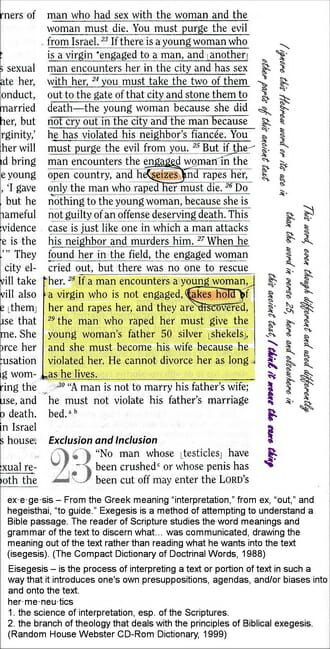 |
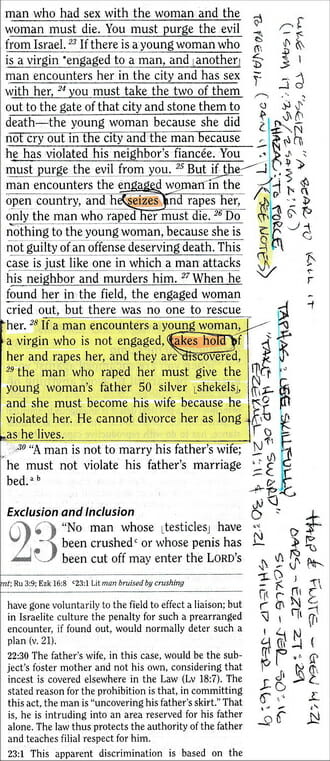 |
Romans 8:7 simply states: “For the mind-set of the flesh is hostile to God because it does not submit itself to God’s law, for it is unable to do so.” (see some commentary below). I can only give so many “helps” to apply to a proper hermeneutic:
- original language,
- Aristotle’s Dictum,
- Greek rules of interpretation (which the courts in Western culture use),
- other verses (the Bible interpret’s the Bible ~ Aristotle’s Dictum),
- cultural and historical keys to the Hebraic culture,
- as well as the others surrounding Israel… etc.
J.C. Ryle said in “Fire! Fire!,” this,
“Beware of manufacturing a god of your own: a god who is all mercy but not just, a god who is all love but not holy, a god who has a heaven for everybody but a hell for none, a god who can allow good and bad to be side by side in time, but will make no distinction between good and bad in eternity. Such a god is an idol of your own, as truly an idol as any snake or crocodile in an Egyptian temple. The hands of your own fancy and sentimentality have made him. He is not the God of the Bible, and beside the God of the Bible, there is no God at all. Beware of making selections from your Bible to suit your taste. Dare not to say, ‘I believe this verse, for I like it. I refuse that, for I cannot reconcile it with my views.’ Nay! But O man, who art thou that repliest against God? By what right do you talk in this way? Surely it were better to say over EVERY chapter in the word, ‘Speak Lord, for thy servant heareth.’ Ah! If men would do this, they would never deny the unquenchable fire.”
To use the laws of logic and reason, to rightfully divide the Word (2 Tim 2:15), to apply laws in the universe discovered by the Greeks — like Newton discovered the law of gravity, it had always been there, it was merely codified.
- Men do not make laws. They do but discover them. Laws must be justified by something more than the will of the majority. They must rest on the eternal foundation of righteousness. ~ Calvin Coolidge
All this [and more] in application to the faith in the construct of the Christian-theistic worldview is something non-regenerate men and women have deep lasting trouble with. For they cannot even see [again, even see] the Kingdom of Heaven (John 3:3)… because regeneration brings a new sight, a new awakening to the soul (1 John 2:29; John 3:6; James 1:18). In other words, Sari HAS fleshed (pun intended) it out to its logical conclusion (Psalm 146:8; Luke 24:31), that is, blindness, rebellion, in the sight of something so evident (2 Corinthians 3:16; 2 Kings 6:17).
It is like saying “look at that ‘fast’ car,” contrasted with “look at that ‘slow’ car.” The car stays the same… the word preceding it defines it’s context… and in our culture it could denote a Pinto [a junker piece of shite!] or a Marzoratti [an expensive sports car].
You see, sexual assault [rape] stayed the same — because the culture looked on sexual purity as important. But the word preceding it defines it’s context — AS WELL AS the actions taken after the context is spoken. So the assault stays the same… the modifier denotes a willingness of a non-willingness in the action (AS WELL as the punishment following such an action ~ death penalty or a “shotgun wedding”).
A shotgun wedding is a wedding that is arranged to avoid embarrassment due to an unplanned pregnancy, rather than out of the desire of the participants. The phrase is an American colloquialism, though it is also used in other parts of the world, based on a supposed scenario (usually hyperbole) that the father of the pregnant daughter, almost by accepted custom, must resort to using coercion (such as threatening with a shotgun) to ensure that the man who impregnated her follows through with the wedding.
The use of duress or violent coercion to marry is no longer common in the U.S., although many anecdotal stories and folk songs record instances of such coercion in 18th- and 19th-century America. Often a couple will arrange a shotgun wedding without explicit outside encouragement, and some religious teachings consider it a moral imperative to marry in that situation.
One purpose of such a wedding can be to get recourse from the man for the act of impregnation; another reason is to ensure that the child is raised by both parents. In some cases, as in early America and in the Middle East, a major objective was the restoring of social honor to the mother.…
(WIKI ~ emphasis added)
This is why leftists can say 1-out-of-4 women are sexually assaulted on college campuses… who would want to send their daughter to such a place like higher education. It isn’t until we see that they define an “unwanted kiss” and “rape” as sexual assault (and everything in-between).
The same idea is applied to these verses ~ Ergo, CONTEXT IS KING!
- This verse reveals how hopelessly incorrigible and utterly destitute the flesh really is. It is a spiritual anarchist. This demolishes any theory that there is a divine spark in man and that somehow he has a secret bent toward God. The truth is that man is the enemy of God. He is not only dead in trespasses and sins but active in rebellion against God. Man will even become religious in order to stay away from the living and true God and the person of Jesus Christ. Man in his natural condition, if taken to heaven, would start a revolution, and he would have a protest meeting going on before the sun went down! Jacob, in his natural condition, engaged in a wrestling match. He did not seek it, but he fought back when God wrestled with him. It wasn’t until he yielded that he won, my friend. Anything that the flesh produces is not acceptable to God. The so–called good work, the civilization, the culture, and man’s vaunted progress are all a stench in the nostrils of God. The religious works of church people done in the lukewarmness of the flesh make Christ sick to His stomach (see Rev. 3:15–16)….
~ J. Vernon McGee, Thru the Bible Commentary: The Epistles (Romans 1-8), electronic ed., vol. 42 (Nashville: Thomas Nelson, 1991), 145.
- The mind-set of the flesh is death because it is enmity against God. The sinner is a rebel against God and in active hostility to Him. If any proof were needed, it is seen most clearly in the crucifixion of the Lord Jesus Christ. The mind of the flesh is not subject to the law of God. It wants its own will, not God’s will. It wants to be its own master, not to bow to His rule. Its nature is such that it cannot be subject to God’s law. It is not only the inclination that is missing but the power as well. The flesh is dead toward God.
~ William MacDonald, Believer’s Bible Commentary: Old and New Testaments, ed. Arthur Farstad (Nashville: Thomas Nelson, 1995), 1709.

Empiricism ~ Or, Falling On Swords (e.g., Self-Refuting)
~ Bahnsen is at the end [bottom] ~
This video is with thanks to Wintery Knight! (See: Apologetics 315):
Topics:
- Atheists misunderstand the nature of faith.
- Atheistic view of epistemology is self-refuting.
- Atheistic view of morality is self-contradictory.
- Atheistic view of free will is self-contradictory.
- Atheists don’t understand theistic arguments.
This is a short presentation of the material presented in this paper. If you want to hear more from Peter, this debate with an academic postmodern relativist is just awesome.
Just a quick aside… while I enjoyed the article, I disagree with some of the positions taken by Mr. Warren. In other words, he reads a bit too much between the lines. That being said, I thoroughly enjoyed the following (you may also note these many excerpts refuting this idea of philosophical naturalism and empiricism here):
The bankrupt epistemology of secular empiricism
The failure of the demarcation criterion between science and religion is part of the general failure of secular epistemology. We have seen that the ID leaders appeal to both (at least when it is convenient), so unless they are going to offer something better than what the best secular philosophers have attempted, which they have not, their view of scientific epistemology must be considered a failure as well. The ID leaders are standing on sinking sand to rely on bankrupt, secular epistemology to defend ID. By keeping the sovereign God of Scripture out of science, ID leaders put themselves in the position of denying a source of rational unity that extends to all the particular facts of experience, which puts them in the indefensible epistemological position of explaining how particular facts without unity between them can be intelligible. A brief review of why secular empiricism fails to provide a basis for science will highlight the problem that the ID leaders face in their opposition to bringing God and the Bible into science. The current status of secular epistemology, particularly secular empiricism, is captured by twentieth-century philosopher Bertrand Russell’s denial that we can know anything whatsoever:
“That scientific inference requires, for its validity, principles which experience cannot even render probable is, I believe, an inescapable conclusion from the logic of probability…. To ask, therefore, whether we ‘know’ the postulates of scientific inference is not so definite as it seems…. In the sense in which ‘no’ is the right answer we know nothing whatsoever, and `knowledge’ in this sense is a delusive vision. The perplexities of philosophers are due, in a large measure, to their unwillingness to awaken from this blissful dream.”
Russell came to recognize that naturalistic empiricism provides no basis for saying that there is a world at all:
“Academic philosophers, ever since the time of Parmenides, have believed that the world is a unity. The most fundamental of my intellectual beliefs is that this is rubbish. I think the universe is all spots and jumps, without any unity, without continuity, without coherence or orderliness or any of the other properties that governesses love. Indeed, there is little but prejudice and habit to be said for the view that there is a world at all.”
We can go back to David Hume to understand the reductio ad absurdum of attempts to justify causation and scientific knowledge on the basis of naturalistic empiricism. Hume saw that with sense impressions as the basis of all knowledge, there is no unity to the world. Nothing can be said to exist but the discrete moment. That a sequence of perceptions reflects a cause-and-effect relationship between external objects cannot be known from experience. Any necessity that might connect external objects that are perceived is not itself a perception, so the assumption of cause-and-effect necessity in the interaction of external objects is unwarranted. Abstract concepts like laws and logic are applied by the human mind to perceptions but they themselves are not perceptions. They all involve continuity over time but bare experience gives us nothing but the discrete moment. Since we have no experience of the future, experience itself provides no basis for believing that the future will be anything like the past. When “we form any conclusion beyond those past instances, of which we have had experience”, Hume says, using his theory of strict empiricism, our reasoning has “no just foundation”.
Even the concept of the self is undermined by strict empiricism since there is no one perception that lasts as long as the self allegedly does. When he sleeps, Hume says that he “may truly be said not to exist”. With no permanence to the self, knowledge and memory of the past, including one’s own past existence, is inconsistent with the claim that all knowledge is through sense experience. Hume was logically rigorous in reasoning from his assumptions, but this led him to an absurd conclusion. On the basis of Hume’s empiricism, we can have knowledge of neither the external world nor our inner selves, neither the past nor the future. Hume’s view of knowledge does not allow for laws of logic, laws of nature, or repeatability of experiments.
Hume resorted to custom and habit as explanations for our belief in the regularity of nature, but custom and habit themselves presuppose continuity over time, and discrete experience can provide no basis for continuity over time.” Hume lamented that the “cold, and strain’d, and ridiculous” conclusions of his philosophical reasoning gave him “philosophical melancholy and delirium”. A history of secular epistemology since Hume would be instructive, although space does not allow it. Nevertheless, Bertrand Russell’s statements from the mid-twentieth century quoted above, that there is no basis for saying that the world has unity or even that the world exists at all, indicate that the problems with secular empiricism that Hume uncovered have not been overcome since then.
[….]
The solution to the modern crises of justifying knowledge and rationality is the Transcendental Argument for the existence of God (or TAG) formulated by Cornelius Van Til.
TAG is an explicitly theistic theory of knowledge, or you might call it theory of fact; therefore it applies to all facts in the world, whether stones or watches. The argument is that the existence of God, an absolute God who is the source of all that exists, necessarily exists in order for knowledge to be possible. Van Til defines an absolute God, which he also calls a “concrete universal” God, as one who is the source of both the diversity of all the particular facts of the world and the unity of the concepts that apply to them. Unity and diversity must be eternally related to each other in the mind of God, because:
- “An abstract diversity is chaos, which is irrational.
- An abstract unity is a pure emptiness, which cannot be an object of thought either.
- The two irrational principles cannot be combined to produce a rational world, where human knowledge, intelligible experience, etc. are possible.”
Compare Van Til’s approach to Dembski’s description of Complex Specified Information (CSI):
“(1) Chance generates contingency, but not complex specified information. (2) Laws… generate neither contingency nor information, much less complex specified information. (3)… no chance-law combination is going to generate information either. After all, laws can transmit only the CSI they are given, and whatever chance gives to a law is not CSI. Ergo, chance and laws working in tandem cannot generate information.”
They both recognize that information cannot be the product of combining chance and law. Just as Van Til affirms that knowledge must be eternal because knowledge can only come from knowledge, Dembski affirms: “Information is sui generis. Only information begets information.” Therefore information must be eternal according to Dembski’s reasoning. Information requires both order and diversity, or “specified complexity” as Dembski calls it, and he recognizes that merely adding chance and law cannot produce specified complexity.
Van Til’s phrase that closely parallels Dembski’s specified complexity is “concrete universal” (see table 1 [below/right]). Van Til argues that a concrete universal God is necessary for the possibility of intelligible experience. This means that the unity of experience (i.e. the `universal’) and the diversity of experience (i.e. the ‘concrete’) must be eternally related to each other. He notes: “Every intellectual effort deals with facts in relations and with relations in facts.” As postmodernists have put it, all facts are interpreted facts.” Facts unrelated to concepts and concepts without content (unrelated to particular facts) are both meaningless, and the two meaningless notions cannot combine to create knowledge. Every particular fact and every universal that applies to every fact are eternally related to each other in the mind of God. Knowledge can only come from knowledge. Human knowledge must be “receptively reconstructive” of God’s original knowledge; humans are not originally constructive of knowledge as the atheists contend. Humans are made in the image of God, thus our knowledge is a reflection of God’s knowledge, meaning that human knowledge can be true but not exhaustive like God’s.”
The difference between Dembski and Van LI here is that Dembski is addressing the narrower topic of information, which applies to a watch but not a stone. Van Til is addressing the broader topic of intelligibility, which applies to any fact, whether a watch or a stone. However, Dembski touches on the issue of intelligibility in his aforementioned chapter where he drops his idolatrous praises of finite gods and sees something of the necessity of the biblical view of God for the possibility of science. He makes this observation that is in harmony with Van Til’s philosophy:
“God, in speaking the divine Logos, not only creates the world but also renders it intelligible…. Einstein claimed: ‘The most incomprehensible thing about the world is that it is comprehensible.’ This statement, so widely regarded as a profound insight, is actually a sad commentary on naturalism. Within naturalism the intelligibility of the world must always remain a mystery. Within theism, on the other hand, anything other than an intelligible world would constitute a mystery?”
[….]
Michael H. Warren, “Intelligent Design Leaders Promote a Naturalistic Epistemology,” Journal of Creation, vol. 29[3] (2015), 115-118
The following is with thanks to Mike Robinson via: God Does Exist:
Empiricism Flops
Empiricism fails as a worldview every time you stub your toe or trip over a rock since this helps demonstrate the sometimes unreliability of our sight; our senses are normally reliable, but we cannot build a worldview on their untrustworthiness. God alone is the necessary truth condition for an intelligible worldview which includes the basic trustworthiness of our five senses.
Atheists can be rational because they borrow rational essentials from the Christian Worldview (CWV); the atheistic WV fails to account for the laws of logic that the CWV underwrites all the while borrowing them out of necessity.
Analysis of anti-theistic materialism demonstrates that it is self-nullifying inasmuch as it fails to give what it does not possess. The material cosmos, as a particular thing, is devoid of a foundation for eternal invariant universals; one cannot hang one’s house on one’s paintings, but one hangs one’s paintings on one’s house. God is the immovable truth required to hang knowledge claims, including atheistic claims.
The Rational Pre-essentials for Knowledge
I will employ a transcendental analysis by determining what the rational pre-essentials are for knowledge and understanding human experience; what must be true to be able to account for intelligibility. The triune God is the transcendental necessity who provides the preconditions for knowledge of reality. Mere men, devoid of immutability and universal rational attainment, cannot supply the transcendental conditions that are needed for the Law of Non-contradiction (LNC), love, and knowledge.
To rightly understand reality one must have universals to generalize the particulars. This implies that the sheer anthropology of atheism cannot supply the general and universal realities that must be present for the necessary and unavoidable transcendental conditions listed beforehand.
Some people claim that knowledge is impossible. Nonetheless if knowledge is impossible, one could not know that knowledge is impossible because that is a knowledge claim. The intelligibility of human experience requires God. Christianity is a WV that provides human reason an unchanging foundation for knowledge. Atheism, naturalism, and skepticism all fail to furnish a foundation for the LNC; thus they cannot provide the permanent footing for knowledge. They can only offer an irrational and incongruous WV.
Unless one believes in God, one cannot account for anything in the universe. God is the underlying and infinite ground for all knowledge, proof, evidence, and logic. It is impossible for God not to exist. He is the truth condition for all knowledge because all human knowledge requires the use of unchanging universals. The omniscient, immaterial, and unchanging God alone provides the a priori essentials for the use of nonphysical, universal, and unchanging universals. Non-believing thought cannot supply the necessary pre-environment for knowledge, thus they fall into futility.
“Of all the offspring of time, Error is the most ancient, and is so old and familiar an acquaintance, that Truth, when discovered, comes upon most of us like an intruder, and meets the intruder’s welcome” (Charles Mackay).
The Christian worldview is true because of the impossibility of the contrary. The contrary of the CWV implies a contradiction inasmuch as the denial of the CWV leaves one without the ontic (ontic: relating to ontology; relating to existence, being) foundation to ground immutable universals such as the laws of thought and moral laws, which are required for knowledge. The denial of knowledge (or its ground) is a self-contradicting endeavor.
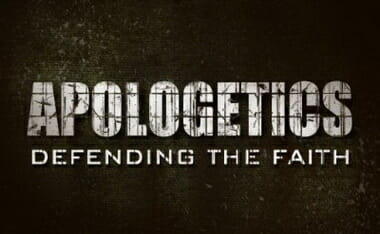
Reasonable Faith In An Uncertain World ~ Dr. Clay Jones
Woodcrest Worldwide Church (2015) – We are honored to have a few of the top philosophers and apologists of our time with us this weekend. We have a different speaker from Biola University at each service on the Columbia South campus!

Conversations with Lemmings: Did God “Create” Evil (Isaiah 45:7)
I won’t get into the long back-and-forth that preceded this exchange. As much as I am confident it shows my own close attention to giants of thinkers that p[receded me as well as the clarity of the theistic position and the inherent implausibility and self-refuting nature of atheism… you can go to the discussion yourself and decide (you would have to be on FaceBook and “like” the group this took place in for the link to work).
Here Daniel said the following:
God being all powerful could have just as easily not created evil and permitted us free will. I am not able to imagine that which is impossible yet I still possess free will. Evil could have just as easy been one of the things I can not comprehend. Your argument is incredibly flawed.
[….]
Notice how I put came to be in “”. It’s simply referring to him being perfect from the get go from the beginning to forever. Never changing perfectly complete in every aspect. Never in need of anything.
I’m talking perfection not your flimsy anthropomorphic idea.
To which I respond in part:
He didn’t create evil. And in a previous post elsewhere you mentioned God coming into existence. You really should study the classical view of God (from Grecian times to ours). Maybe something like (I am struggling for something basic for you, because you seem not to be lifting with your legs on what I put down), Philosophy for Dummies, by Tom Morris. And, Christianity For Dummies, by Richard Wagner and Kurt Warner. [I didn’t mention this in the conversation, but the best intro to the topic of basic Christian beliefs is a book by theologian Wayne Grudem tiled “Bible Doctrine: Essential Teachings of the Christian Faith“]
Because you say stuff that paints a giant straw-man and this interferes with your conclusion.
- Mortimer J. Adler rightly points out that while many Christians are quick in responding to the conclusions in an argument often times the Christian is unaware that the point of departure is not in the conclusion, but in the starting premise, the foundational assumptions.
Norman L. Geisler & Peter Bocchino, Unshakeable Foundations: Contemporary Answers to Crucial Questions About the Christian Faith (Minneapolis: Bethany House, 2001), 20-21.
Daniel retorted with…
Again you are wrong. Hold on I’ll be back with the verse….Isaiah 45.7
- I form the light, and create darkness: I make peace, and create evil: I the LORD do all these things.
This verse, ISAIAH 45:7 — for context — reads:
- I form light and create darkness, I make well-being and create calamity, I am the Lord, who does all these things. (ESV)
- I form light and create darkness, I make success and create disaster; I, Yahweh, do all these things. (HCSB)
- The One forming light and creating darkness, Causing well-being and creating calamity; I am the Lord who does all these. (NASB)
- I form light and create darkness, I make harmonies and create discords. I, God, do all these things. (The Message)
Here is the Hebrew:
(Click to enlarge)
Note that Daniel used the KJV, whereas most versions since 1611 translate this word/thought (“and create evil“) better due to communication and modern access to many more manuscripts. Really, the context of the preceding verses should be included… you can read it here. I reference a previous discussion of this person [probably young man] coming at any ancient text with some parameters. He made it clear that his viewpoint is the only one that mattered (implicitly at least).
I responded
I will respond to the verse… it will offer you a great opportunity to be a literary critic… but first, here is a section from Philosophy for Dummies:
ROBOTS AND COSMIC PUPPETRY: THE SCIENTIFIC CHALLENGE TO FREEDOM
Since at least the time of Sir Isaac Newton, scientists and philosophers impressed by the march of science have offered a picture of human behavior that is not promising for a belief in freedom. All nature is viewed by them as one huge mechanism, with human beings serving as just parts of that giant machine. On this view, we live and think in accordance with the same laws and causes that move all other physical components of the universal mechanism.
According to these thinkers, everything that happens in nature has a cause. Suppose then that an event occurs, which, in context, is clearly a human action of the sort that we would normally call free. As an occurrence in this universe, it has a cause. But then that cause, in turn, has a cause. And that cause in turn has a cause, and so on, and so on [remember, reductionism].
- “Everything is determined, the beginning as well as the end, by forces over which we have no control. It is determined for the insect as well as for the star. Human beings, vegetables, or cosmic dust, we all dance to a mysterious tune, intoned in the distance by an invisible player” ~ Albert Einstein.
As a result of this scientific world view, we get the following picture:
- Natural conditions outside our control…
- cause…
- Inner bodily and brain states,
- which cause…
- mental and physical actions
But if this is true, then you are, ultimately, just a conduit or pipeline for chains of natural causation that reach far back into the past before your birth and continue far forward into the future after your death. You are not an originating cause of anything [this includes brain activity of all degrees, that is, love, pain, etc.). Nothing you ever do is due to your choices or thoughts alone. You are a puppet of nature. You are no more than a robot programmed by an unfeeling cosmos.
Psychologists talk about heredity and environment as responsible for everything you do. But then if they are, you aren’t. Does it follow that you can then do as you please, irresponsibly? Not at all. It only follows that you will do as nature and nurture please. But then, nature on this picture turns out to be just an illusory veil over a heartless, uncaring nature. You have what nature gives you. Nothing more, nothing less.
Where is human freedom in this picture? It doesn’t exist. It is one of our chief illusions. The natural belief in free will is just a monstrous falsehood. But we should not feel bad about holding on to this illusion until science corrects us. We can’t have helped it.
This reasoning is called The Challenge of Scientific Determinism. According to determinists, we are determined in every respect to do everything that we ever do.
This again is a serious challenge to human freedom. It is the reason that the early scientist Pierre Laplace (1749-1827) once said that if you could give a super-genius a total description of the universe at any given point in time, that being would be able to predict with certainty everything that would ever happen in the future relative to that moment, and retrodict with certainty anything that had ever happened in any moment before that described state. Nature, he believed, was that perfect machine. And we human beings were just cogs in the machine, deluded in our beliefs that we are free.
(Tom Morris, Philosophy for Dummies, 133-134)
Previously I noted his view of Consciousness was ill-placed:
What merit would attach to moral virtue if the acts that form such habitual tendencies and dispositions were not acts of free choice on the part of the individual who was in the process of acquiring moral virtue? Persons of vicious moral character would have their characters formed in a manner no different from the way in which the character of a morally virtuous person was formed—by acts entirely determined, and that could not have been otherwise by freedom of choice.
Mortimer J. Adler, Ten Philosophical Mistakes (New York, NY: Touchstone, 1985), 154.
At any rate, here is my response to Daniel’s verse he quoted most-probably from an atheist website:
A historian and critic of ancient literature would ask the following questions:
- Who was the writer?
- To whom were they writing?
- Is the choice of words, wording, or word order significant in this particular passage?
- What is the cultural, historical context?
- What was the author’s original intended meaning?
- How did the author’s contemporaries understand him?
- Why did he say it that way?
By doing this one shows a maturity level past taking a verse out of context. And again, you would want to give the benefit of doubt to the document [Aristotle and our court system] with the following:
1) Rule of Definition: Define the term or words being considered and then adhere to the defined meanings.
2) Rule of Usage: Don’t add meaning to established words and terms. Ask what was the common usage in the culture at that time period.
3) Rule of Context: Avoid using words out of context. Context must define terms and how words are used.
4) Rule of Historical background: Don’t separate interpretation from historical investigation.
5) Rule of Logic: Be certain that words as interpreted agree with the overall premise.
6) Rule of Precedent: Use the known and commonly accepted meanings of words, not obscure meanings for which there is no precedent.
7) Rule of Unity: Even though many documents may be used there must be a general unity among them.
8) Rule of Inference: Base conclusions on what is already known and proven or can be reasonably implied from all known facts.
[I discuss the above more in-depth here.]
So, for example, I will post one thought on the matter by CARM:
- “We can see that the Bible teaches that God is pure and does not approve of evil and that the word, rah (evil), in Hebrew can mean many things and that contextually the verse is speaking of calamity and distress. Therefore, God does not create evil in the moral sense but in the sense of disaster or calamity.”
And from Come Reason Ministries:
- “Evil means natural, and not moral evil, or sin. Herderson says ‘affliction, adversity’; Calvin, ‘afflictions, wars, and other adverse occurrences.’ Whichever interpretation may be adopted, none of the above texts, nor any others when properly explained, sanction the revolting proposition that God is the author of sin.”
Take hurricanes as an example. Hurricanes cause havoc, mayhem, and many times death and suffering. Yet, our planet would be dead without them (see my post where similar to you, arguments made against God end up being proof for Him.
So are you being thorough in your studies, knowing that which you refute? or are you being like the masses of uneducated voters/thinkers and just “willy nilly” taking stuff for granted and thinking you have a good argument?
Honorable mentions of resources on this verse:
Did God Create Evil – Does the Bible Say So? (Evidence for God):
Isaiah 45:7 contrasts opposites. Darkness is the opposite of light. However, evil is not the opposite of peace. The Hebrew word translated “peace” is shâlôm,2 which has many meanings, mostly related to the well being of individuals. Râ‛âh,3 the Hebrew word translated “evil” in the KJV often refers to adversity or calamity. There are two forms of the word. Strong’s H7451a most often refers to moral evil, whereas Strong’s H7451b (the form used here) most often refers to calamity or distress. Obviously, “calamity” is a better antonym of “peace” than “evil.”
Why does Isaiah 45:7 say that God created evil? (Got Questions?):
The context of Isaiah 45:7 makes it clear that something other than “bringing moral evil into existence” is in mind.
Here are a few commentaries on the verse[s]:
6. Comfort from Cyrus, God’s Anointed (Chap. 45)
45:1–6 The LORD calls Cyrus His “anointed” (the same word as “messiah” in Hebrew) because the Persian monarch was a prototype of the Messiah who would give final deliverance to His people. Jehovah promises to give him victory over nations, principally Babylon, to remove all hindrances to his conquests, and to hand over to him tremendous amounts of hidden riches in secret places. Still addressing Cyrus, the LORD speaks of Himself as the only true God, who calls Cyrus by name, who surnames him as anointed and shepherd (44:28), and who equips him for his mission. God does all this for the sake of His people, and so that the whole world may know that He alone is the LORD.
45:7 Verse 7 does not mean that God creates moral “evil,” as some have claimed, based on the King James Version and other early translations.
Delitzsch points out that the early “Christian” heretic Marcion, and the heretical Valentinians and other Gnostic sects, abused this text to teach that the God of the OT was “a different being from the God of the New.”
Addressing the problem of evil (including calamity, no doubt), Delitzsch continues, “Undoubtedly, evil as an act is not the direct working of God, but the spontaneous work of a creature endowed with freedom.”
- William MacDonald, Believer’s Bible Commentary: Old and New Testaments, ed. Arthur Farstad (Nashville: Thomas Nelson, 1995), 972.
45:5–7 The Lord’s Witness to Cyrus
In the first stanza (45:5–6a) and from this center-stage position, the Lord continues to address Cyrus with the word I am the LORD. Though Cyrus does not know the Lord (cf. 45:4), the Lord knows Cyrus and equips him. I am using the word equips to refer to all of the ways in which the Lord has strengthened Cyrus (45:1–4). The goal of that equipping was to set the Judean exiles free (45:13). The equipping of Cyrus takes place so that they may know … that there is no one besides me (45:6). It is not clear who they might be. The NIV substitutes the word men, meaning people in general. But this is conjecture. The more likely antecedent for they would be Jacob-Israel (45:4). But why would the Lord’s equipping of Cyrus make it possible for Jacob-Israel to know that there is no one besides the Lord? The answer lies at the end of 45:1–13. Cyrus will permit Jerusalem to be rebuilt; Cyrus will set the Judean exiles free (45:13). Jacob-Israel will know that the Lord has delegated power to Cyrus but that it is the LORD’s power that needs to be reckoned with.
The phrase I am the LORD opened the first stanza and now it opens the second (45:6b–7). This is followed by parallel lines describing the Lord as
forming light and creating darkness,
making peace and creating distress. (45:7 AT)
These lines employ language from Genesis 1 and 2 (forming, creating, making). In the second line the Lord lays claim to making peace as well as creating distress (ra‘). The Hebrew noun ra‘ has a range of meanings (cf. evil, KJV; disaster, NIV; woe, NRSV; calamity, JB). It is a mistake to elaborate a theology of God as the creator of evil from this text (see “Creating Evil” in TLC below).
The main point in the witness to Cyrus in 45:5–7 is the Lord’s singularity (no one else) and his activity (doing all these things). God’s power may be seen in creation and in history. God’s sovereignty is over Cyrus; Cyrus does not control God.
- Ivan D. Friesen, Isaiah, Believers Church Bible Commentary (Scottdale, PA; Waterloo, ON: Herald Press, 2009), 277.
45:5–7. Again the uniqueness of God is stressed. The fact that there is no other is stated in verses 5–6, 14, 18, 21–22 (also see 43:11; 44:6; 46:9). In Cyrus’ day the Lord was not universally acknowledged, but eventually He will be (cf. Phil. 2:10–11). People will realize that all that happens-light (life), darkness (death), prosperity, and disaster (not “evil” as in the KJV; cf. Amos 3:6)—comes from God. As the sovereign LORD of the universe He can do everything.
- John A. Martin, “Isaiah,” in The Bible Knowledge Commentary: An Exposition of the Scriptures, ed. J. F. Walvoord and R. B. Zuck, vol. 1 (Wheaton, IL: Victor Books, 1985), 1100.
CREATION OF THE UNIVERSE
Here is a remarkable statement relative to the creation of the universe before all time. God says:
I form the light, and create darkness: I make peace, and create evil, I the LORD do all these things [Isa. 45:7].
Zoroastrianism began in Persia. It teaches that Mazda is the god of light. God says He creates light, and that it is no god. The Persians were getting very close to the truth. Many have wondered why they worshiped one god in the midst of idolatry. Well, you must remember that they came in contact with the nation Israel, and Israel was a witness to the world. In Zoroastrianism darkness was Ahriman, the god of evil. God takes responsibility for creating the darkness also.
“And create evil”—the word evil does not mean wickedness in this instance, but rather “sorrow, difficulties, or tragedies”—those things which are the fruit of evil, the fruit of sin. This is the Old Testament way of saying, “The wages of sin is death …” (Rom. 6:23). If you indulge in sin, there will be a payday for it!
By the way, let me introduce something else at this point, since we are living in a day when it is said that good and evil are relative terms, that whatever you think is good, is good. The argument is put forth: The Bible says “Thou shalt not kill” and “Thou shalt not steal” (Exod. 20:13, 15). But what is the Bible? Who should obey it? Or why should we listen to the God of the Bible?
The Lord has another very cogent argument. God says that if you indulge in sin, you will find that sin has its payday. It pays a full wage, by the way. This is what God is saying through Isaiah. God has so created the universe that when you break over the bounds that He has set, you don’t need a judge, a hangman’s noose, or an electric chair; God will take care of it.
He says, therefore, that He is the One who creates light and darkness. He is answering Zoroastrianism which worshiped the god of light. God says, “I want you to know that light is no god; I created it.
- J. Vernon McGee, Thru the Bible Commentary: The Prophets (Isaiah 36-66), electronic ed., vol. 23 (Nashville: Thomas Nelson, 1991), 71–72.
ISAIAH 45:7—Is God the author of evil?
PROBLEM: According to this verse, God “creates good and evil” (KJV, cf. Jer. 18:11 and Lam. 3:38; Amos 3:6). But many other Scriptures inform us that God is not evil (1 John 1:5), cannot even look approvingly on evil (Hab. 1:13), and cannot even be tempted by evil (James 1:13).
SOLUTION: The Bible is clear that God is morally perfect (cf. Deut. 32:4; Matt. 5:48), and it is impossible for Him to sin (Heb. 6:18). At the same time, His absolute justice demands that He punish sin. This judgment takes both temporal and eternal forms (Matt. 25:41; Rev. 20:11–15). In its temporal form, the execution of God’s justice is sometimes called “evil” because it seems to be evil to those undergoing it (cf. Heb. 12:11). However, the Hebrew word for evil (rā) used here does not always mean moral evil. Indeed, the context indicates that it should be translated, as the NKJV and other modern translations do, as “calamity.” Thus, God is properly said to be the author of “evil” in this sense, but not in the moral sense—at least not directly.
Further, there is an indirect sense in which God is the author of moral evil. God created moral beings with free choice, and free choice is the origin of moral evil in the universe. So, ultimately God is responsible for making moral creatures who are responsible for moral evil. God made evil possible by creating free creatures, but the free creatures made evil actual. Of course, the possibility of evil (i.e., free choice) is itself a good thing. So, God created only good things, one of which was the power of free choice, and moral creatures produced the evil. However, God is the author of a moral universe and in this indirect and ultimate sense is the author of the possibility of evil. Of course, God only permitted evil, but does not promote it, and He will ultimately produce a greater good through it (cf. Gen. 50:20; Rev. 21–22).
The relation of God and evil can be summarized this way:
| GOD IS NOT THE AUTHOR OF EVIL In the sense of sin Moral evil Perversity Directly Actuality of evil |
GOD IS THE AUTHOR OF EVIL In the sense of calamity Non-moral evil Plagues Indirectly Possibility of evil |
- Norman L. Geisler and Thomas A. Howe, When Critics Ask: A Popular Handbook on Bible Difficulties (Wheaton, Ill.: Victor Books, 1992), 271–272.

Numbers 31:15 ~ “Have You Allowed All the Women to Live?”
This is a bit of a convoluted rant from YouTube by a cult member (or at least, a supporter). My response will not be my own, but Matt Flannagan and Paul Copan’s response to the verse mentioned by this cult member.
…the teachings of the Bible? You mean where “God” instructs Moses and them to slaughter entire cities including babies(except the virgin women) and rape women…or where Jesus allows his enemies to capture and crucify him? Who are you trying to fool…thank goodness Fard Muhammad came to kill religion…if you are standing by the Bible as your moral base then you have no moral base to stand on….you would mutilate your son’s penis because your poison bible tells you to….the Father Allah was a greater God than Jesus…at the very least he didn’t go out like a punk like your boy did…the enemy of the planet right now is the global system of white domination…and this system oppresses everyone including so called white folks…you seriously lack understanding…the Father Allah was not anti white or pro black…
…your poison book is in every hotel room and it states in the old testament….. “Moses, Eleazar the priest, and all the leaders of the people went to meet them outside the camp. But Moses was furious with all the military commanders who had returned from the battle. “Why have you let all the women live?” he demanded. “These are the very ones who followed Balaam’s advice and caused the people of Israel to rebel against the LORD at Mount Peor. They are the ones who caused the plague to strike the LORD’s people. Now kill all the boys and all the women who have slept with a man. Only the young girls who are virgins may live; you may keep them for yourselves.” ….om just trying to show you how ridiculous you look promoting such a filthy poisonous book and at the same time judging a cipher that was only founded to fix the mess that european christians started…and now we gotta fix the mess in your video….Allah the chosen one, who left temple 7 in 1963 and borned the first 5 percenters was no racist and if he was a racist he problably would be alive today…its like you damed if you do and u damned if you don’t with yaw people…nothing pleases you except for mucus, pus and white blood cells…
This is with thanks to Moral Apologetics. Here is the text from the wonderful book, Did God Really Command Genocide?
Number 31:15: “Have You Allowed All the Women to Live?”
The third example Morriston cites to make his point is the defeat of Midian as recorded in Numbers 31. The Israelites fought against Midian, as the Lord commanded Moses, and killed every man (v. 7). After the battle, however, Moses commanded Israel to kill all the boys and every woman who has slept with a man, but save for yourselves every girl who has never slept with a man. Morriston says Yahweh was angered by the fact that some young Israelite men had worshiped Baal alongside their new Midianite brides, writing, “Not only must the Israelites be punished, but the Midianites must be punished for causing the Israelites to be punished.” God’s stated reasons, according to Morriston’s thinking, are inadequate.
But Morriston appears to have misread the text. First, consider his claim that the text explicitly states that God’s reason for commanding the killing of the Midianite women and boys was “spiritual infection” because “some young Israelite men had worshiped Baal alongside their new Midianite brides.” There are several problems with this.
First is the fact that, in the text Morriston cites (Num. 31:17-18), God himself does not explicitly command Israel to kill all the Midianite women and boys. God’s command to Moses regarding the Midianites is actually recorded in Numbers 25:17-18 and 31:1-2. God explicitly commands Israel to respond to the Midianites’ spiritual subterfuge by fighting against the Midianites and defeating them. The reasons why Israel is to obey isn’t the spiritual infection of women as Morriston says, but rather the fact that Midian has been hostile toward and deceived Israel.
The Numbers 31 text does not explicitly attribute the command to kill the women and boys to God, but to Moses. Morriston acknowledges this, but suggests three reasons why this observation doesn’t come to much. (1) Moses is regularly characterized as being very close to Yahweh, faithfully obeying his instructions most of the time; (2) Yahweh expresses no disapproval of anything Moses does in this story; and (3) Yahweh himself is the principal instigator of the attack on Midian.
These responses, however, are inadequate. Consider the last point first. The fact that someone is the “principal instigator” of an attack doesn’t entail that he approves of every single action that takes place within the battle in question. Similarly with 2: the lack of explicit disapproval in the text does not entail approval. Morriston’s argument is an appeal to ignorance; absence of evidence is not evidence of absence. It is not uncommon in biblical narratives for authors to describe sinful behavior without expressing explicit disapproval. In most cases, no doubt, the author expects the reader to know certain actions are right and wrong.
Finally, regarding 1, the fact that someone is portrayed in the text as close to God or faithful to him does not mean that every action he is recorded as doing is commanded or endorsed by God. Consider David, or Abraham.
A second instance of Morriston misreading the text is that not only does he attribute Moses’s reasons to God; he also misstates the reasons Moses does give in the context. The real issue is that the Midianite women had been following the devious advice of the pagan seer, Balaam, who had been explicitly commanded by God not to curse Israel. Balaam had led the Israelites into acting treacherously at Baal-Peor. This is the clearly stated issue (31:16). What occurs, when the background is taken into account, is not that some Israelites marry Midianite women, but rather these women use sex to seduce Israel into violating the terms of their covenant with God—an event that threatened Israel’s very national identity, calling, and destiny. This act was in fact deliberate.
So Morriston’s comments are far off the mark when he insists that the Midianites could not have been trying to harm the Israelites by inviting them to participate in the worship of a god in whom they obviously believed. The whole point of the exercise was to get God to curse Israel so that a military attack could be launched by Moab and Midian. The picture isn’t one of innocent Midianite brides, but acts tantamount to treason and treacherous double agents carrying on wicked subterfuge.
Note that the problem wasn’t God’s opposition to Israelites marrying Midianites per se. Indeed, Moses married Zipporah, a Midianite, and he received wise counsel from his father-in-law, Jethro, a Midianite priest.

